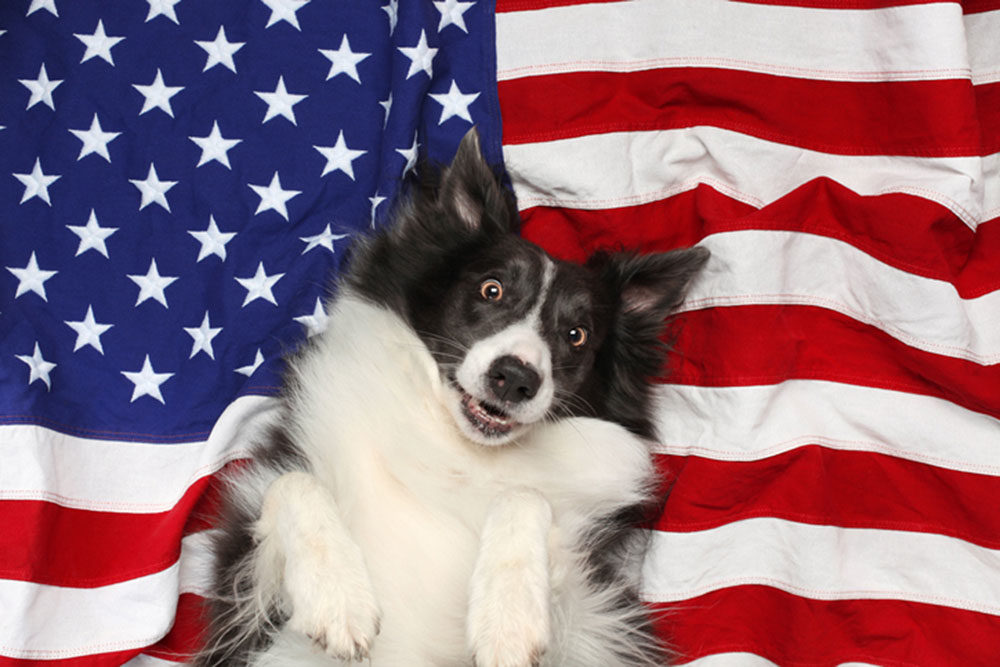
iStock
BACK TO work, back to school. Bye, bye summer. But let’s not forget how gorgeous a month September is. And, just FYI, I’m not putting away my white jeans anytime soon.

iStock
BACK TO work, back to school. Bye, bye summer. But let’s not forget how gorgeous a month September is. And, just FYI, I’m not putting away my white jeans anytime soon.
REMEMBER WHEN the end of August was the time to overhaul your wardrobe? Those days are long gone. Even though fall is my favorite time for new clothes, environmental awareness, fear of overflowing closets, along with sky-high prices on coveted items, have led me to think/shop strategically. With that in mind, I asked two local Pittsburgh shopping experts their advice on smart updates for the coming season.
Dina Sebastian-Valant may have been a psychology major at Duquesne University, but as an incurable clothing lover, she always dreamed of having a store. She opened the Dina Ellen boutique on Walnut Street in Shadyside 26 years ago and has been there since.
Skirts are back, and Sebastian-Valant is a fan of swishy, longish pleated ones that you can pair with a slouchy cashmere sweater, either long or short-sleeved. “An animal print looks fresh, maybe something checked or plaid, too,” she says. “A wide or skinny belt will update the blazer/jacket you already own; a scarf is an easy way to completely change an outfit.” Those trendy, over-the-knee boots may be better suited to 6-foot-tall, willowy models who can easily tuck their skinny jeans-clad super-trim legs into them. Says Sebastian-Valant,”It’s not a boot everyone can wear, nor can you wear it with everything. Alternatively, a bootie goes with dresses, jeans and pants. You can also get mileage out of a long cardigan. Pair it with jeans, a T-shirt and boots, and you have a nice, effortless look.”
Bear Brandegee, a Pittburgh-based style strategy coach with 20 years of experience in branding and marketing and training as an image consultant, recommends her clients look at Pantone’s color trends report for autumn (which includes a burgundy, forest green, a spicy brown and an avocado green). “Pick a color or two from the season that resonates with you. Find a piece in that color—a coat, a scarf, a jacket—that you’ll get a lot of wear out of and see how to work it into your wardrobe.”
“Shoes more than anything can give you a fresh look,” says Brandegee, who just bought a studded ankle cowboy boot that she wears for everything. But before buying, she says, “Go through your closet. Ruthless cleaning and paring down to the things you absolutely love will make getting dressed much more fun. Then create your favorite three outfits from what’s left. Buy a great boot, a great coat and one great accessory (a scarf in the color of the season, a statement necklace or a fabulous belt), and you should be good to go.” Brandegee is “very into colors and textures” and loves sweater tights with patterns. “But be aware that color on your legs can cut you up. Keep it monochromatic or tonal.”
—Janet Kelly
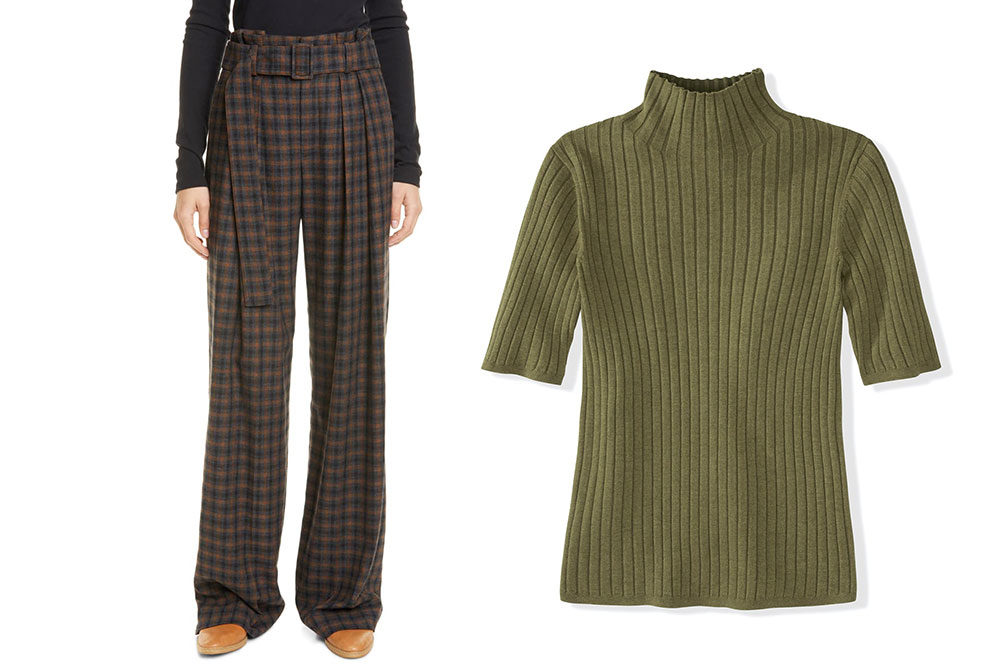
LEFT: High-waisted, wide-leg pants, especially those with a polished plaid or check pattern, can refresh a wardrobe of too many black jeans. The drapey, buckle belt on Vince’s wool-blend Wide Leg Pants ($365, Nordstrom) is a nice detail. RIGHT: This Ribbed Mock Neck Top’s ($68, 525 America) updated silhouette (neckline, fitted, slightly above-the-elbow sleeves) takes it beyond the just-a-basic category. Pair with pants as well as with flowy skirts. It’s also available in charcoal, sand and black.
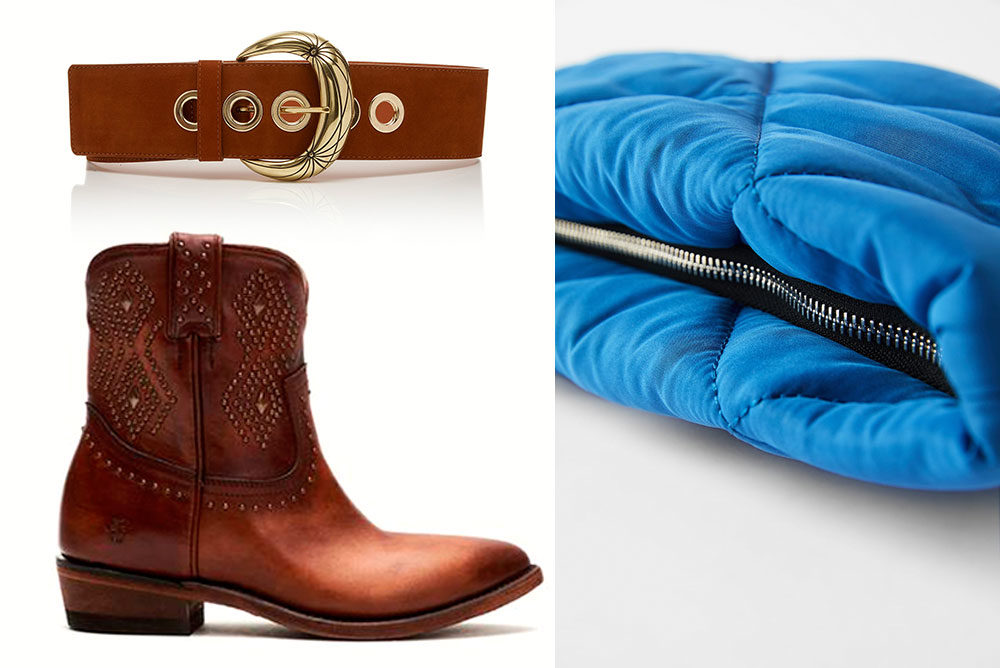
BELOW LEFT: Roping steer not required to wear the Frye Company’s Billy Stud Short boot ($368). Stylishly swagger when you wear them. ABOVE LEFT: Maison Boinet has been making belts since 1858, but the brand’s wide Nubuck Belt (also available in black, $135, Moda Operandi), made from leather treated to look like suede, is the perfect accessory to add some sass to your navy, charcoal or cream jacket. RIGHT: Ever since I set eyes on Bottega Veneta’s Pouch (starting at $2,400), I’ve been swooning over it. Zara’s Quilted Clutch has the same sort of look and squishy feel for $2,371 less. It would look smashing against all black or white. It also comes in écru.
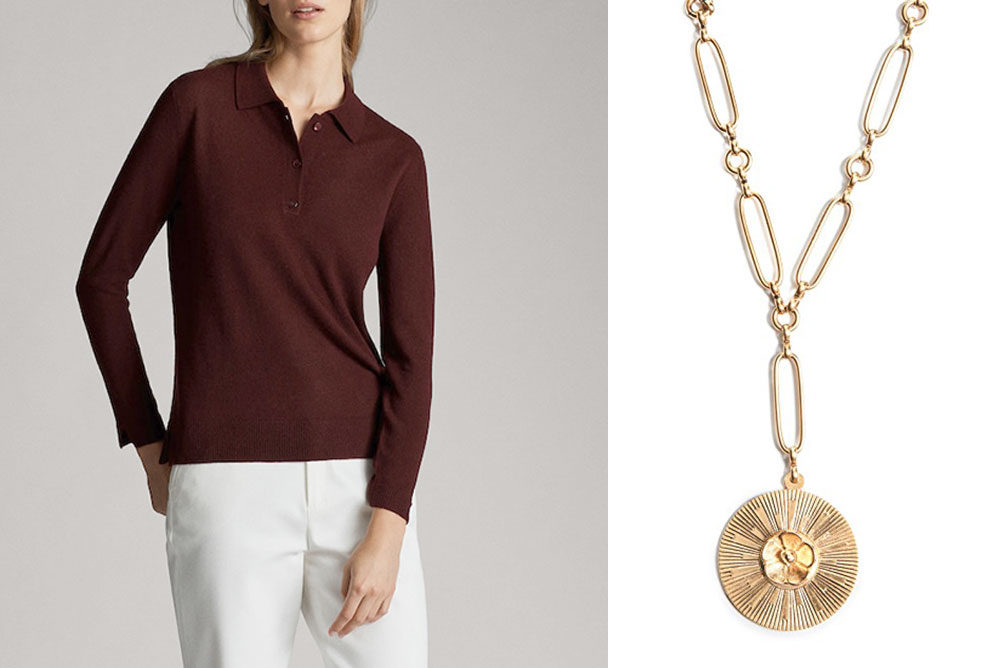
LEFT: If this sweater had a Ralph Lauren label, it would be upwards of $500. Massimo Dutti’s lush burgundy 100% Cashmere Polo Sweater with a three-button henley placket is $199. Wear it in early fall with white cropped jeans, later on with a curvy knit skirt. RIGHT: When a cashmere T-shirt or turtleneck calls out for adornment, respond with a vintage-y etched coin medallion pendant hung from a chunky chain. Eliza Brinker and Eliza’s Sunshine and Lemonade Necklace is $118 at Shopbop.
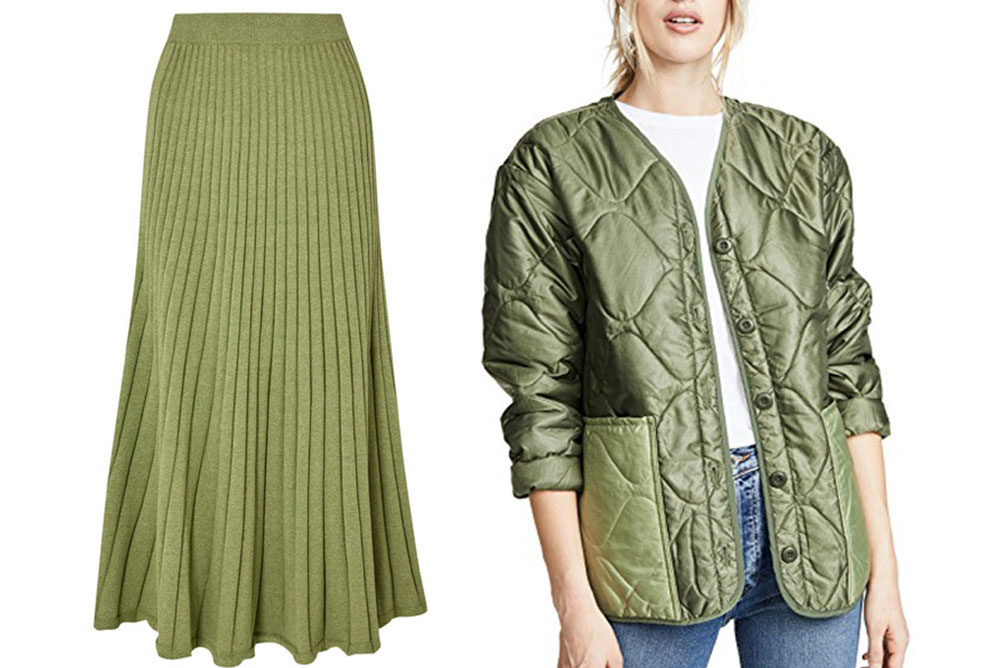
LEFT: What I like about Anna Quan’s Cleo Ribbed Cotton Midi Skirt ($305, Net A Porter) is that it’s a knit (look mom, no wrinkles) and the elasticized waistband means you just pull it on. The ribbing and flared hem create a flattering swish. It also has a matching top. Tuck it in, and it looks like a dress. RIGHT: Designer Anine Bing’s Andy Bomber Jacket ($299, Shopbop) has an entirely new update on the classic with lightweight, plush quilt fabric, a collarless neckline, military green color and contrasting big pockets. Toss it over a skirt or a dress or T-shirt and jeans.
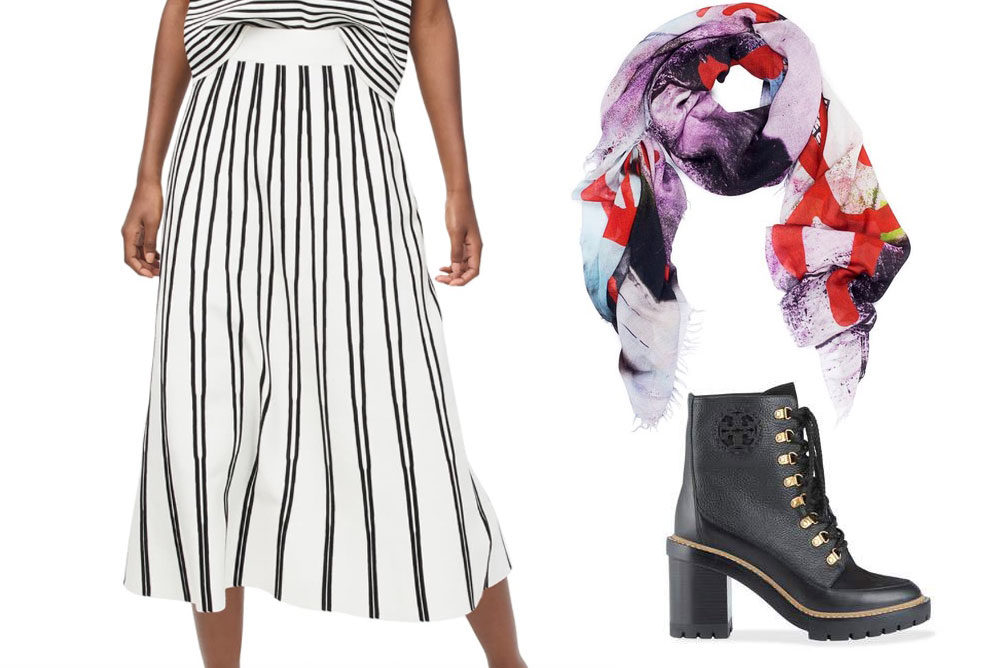
LEFT: Ease into fall from summer with J. Crew’s Textured Striped Pull-on Flare Sweater Skirt ($128, Nordstrom, limited size availability. Also at J. Crew). We’ve already mentioned our love of the pull-on skirt. Pair this one with a boxy T-shirt for the last days of summer. ABOVE RIGHT: Each Suzi Roher, one-of-a kind scarf is based on original art or photography that morphs into beautifully layered colors when worn. Says Dina Ellen’s Dina Sebastian-Valant, “Depending on how you fold it, you get a different color palette each time. A scarf is perfect for injecting a pop of color and/or adding print to a solid outfit.” Suzi Roher’s Paris Guy scarf ($325), a blend of modal and silk, is a montage of graffiti taken on the street while photographing in Paris. BELOW RIGHT: Says Bear Brandegee, “The look I find to be fun is a thick-soled boot with a high heel. It’s a hippy work boot look. Because of the sole, it’s a comfortable shoe to wear.” Tory Burch’s Miller Lug-Sole Booties are $458 at Neiman Marcus.
MyLittleBird often includes links to products we write about. Our editorial choices are made independently; nonetheless, a purchase made through such a link can sometimes result in MyLittleBird receiving a commission on the sale, whether through a retailer, an online store or Amazon.com.
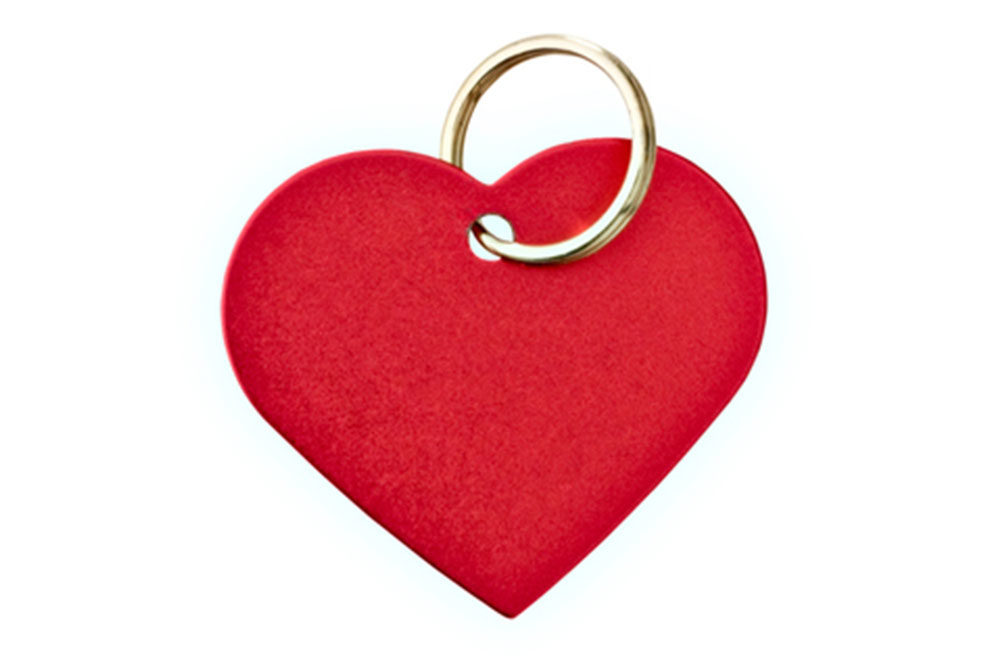
iStock
THREE DAYS ago my friend Em died. She got the most out of each day, never complained and always had a smile on her face. She was also a trusted neighbor who ran around looking for a good time, a pat on the head and, with any luck, a tasty treat.
Everywhere she went she took a tennis ball with her, which she dropped at your feet and waited for you to throw. She’d chase it in a frenzy of excitement, then bring it back for you to throw it again. She wasn’t crazy, she was a dog. A black Labrador to be exact. At the age of twelve and a half she simply gave out, following a long walk in the woods and a swim in a lake with her owner and best friend.
Em was buried next to our neighborhood pond. Nearby were other graves of neighborhood dogs who had cheered us with their antics and boundless energy, and then gone. Em’s funeral was attended by about 30 mourners. All members of the dead pets society, we shared stories of some of the other dogs we had loved and painfully lost.
It’s been raining hard today and I’m sad to think that Em is out there, deep under the grass and dirt getting pounded by the elements and not snuggling inside in her cozy bed. But that’s what happens to all of them when we live long enough to love them and then let them go.
—Andrea Rouda
Andrea Rouda blogs at The Daily Droid.

iStock
Summer’s ending and your colored-treated hair is showing signs of strain. We can relate. ICYMI: Gigi Anders’s Q&A-post with celebrity colorist Rita Hazan.
AFTER A GOOD HAIRCUT, hair color is the biggest investment you can make to maintain your mane year-round. Particularly now, color-treated hair can look dry and faded.
We spoke with Rita Hazan for words of wisdom.
GA: Rita, is there anyone left who doesn’t color their hair?
RH: This makes me laugh out loud! No. Even kids color their hair these days.
GA: Is there any kind of hair type or texture that should NOT be color-treated?
RH: No. You just have to be careful if the hair is fragile.
GA: How does color affect the health of the hair? Can it actually improve it?
RH: It’s definitely a myth that color damages hair. It’s not the color, it’s the person using the color. It doesn’t matter what color you use; all color is a little bit harsh on the hair because you are changing the naturalness of the hair. Color gives hair volume and plumps the cuticle, while glosses can make hair look shiny.
GA: How is color-treated hair different from virgin hair in terms of choosing the right shampoo and conditioner?
RH: People with color-treated hair need to use shampoos and conditioners especially for color-treated hair because others are too harsh. It makes a big difference. It is important to use a sulfate-free shampoo because others can be stripping. Dandruff shampoos also have a stripping agent unless it says it is for color-treated hair. If you change shampoo you might see a 90 percent difference in how long your color lasts. You can use any shampoo or conditioner that says “color protecting” because they all have similar ingredients that help preserve color. Color-safe shampoos usually have a complex in them that is specific to keep the color from fading and getting dull.
GA: Where have people gone wrong when they say they have color damage?
RH: It’s the person who must know how to control the damage. The colorist is in charge of the color process and over-processing should never happen with a skilled colorist. Some people over-color their hair. Every three or four weeks will cause damage. You have to respect the process. Hair doesn’t need to be colored all the time; retouching the roots is fine. Also, not conditioning and not using the right [at-home] products is damaging.
GA: What causes color depletion and how can we stop or delay it between treatments?
RH: A lot of fading happens naturally through washing, which strips color. It naturally happens over time, and the vibrancy fades away. You have to maintain the color at home. You have to do treatments and use good shampoos and conditioners. You can also use my Ultimate Shine Color Gloss because it will prevent fading while also keeping the hair shiny and healthy.
GA: How (if at all) does a single process versus highlights affect color duration and overall hair health?
RH: Single process is the least harsh and damaging on the hair. It is done with either semi-permanent or permanent color. Highlights are typically done with bleach to give you the extra lift without turning orange.
GA: In terms of maintaining hair health, is there any difference between foil highlights and balayage?
RH: I only use foils because it’s less damaging to the hair long term, and it’s faster.
GA: What effect does sunlight have on colored hair? How can we prevent UV damage?
RH: UV rays do the same to your hair as they do to the skin. It gets dehydrated and loses its vitamins, and then you lose the pigment. Use products that have SPF and UV protection. Apply to hair a few times while in the sun—it protects hair just as you would put SPF on to protect your skin.
GA: When looking for a colorist, what qualities or credentials should people be looking for?
RH: If you see someone and like their color, ask who does it. Also, when you call a salon, the person who answers the phone can direct you. Ask them who the best person is for what you’re looking to get. Educate yourself as much as possible and then research that person. You don’t have to book right then. You can look on Instagram; a lot of people post their work.
GA: What are your favorite shampoo and conditioner brands for color-treated hair? And how important is a weekly moisturizing mask?
RH: I love Shu Uemura and Inphenom. A weekly moisturizing mask is important because you are only at the salon every two months so you have to maintain your hair at home. Between shampoo, straightening and blow-drying, you have to add nutrition back into the hair.
—Gigi Anders
Some product suggestions to keep your color looking lively.
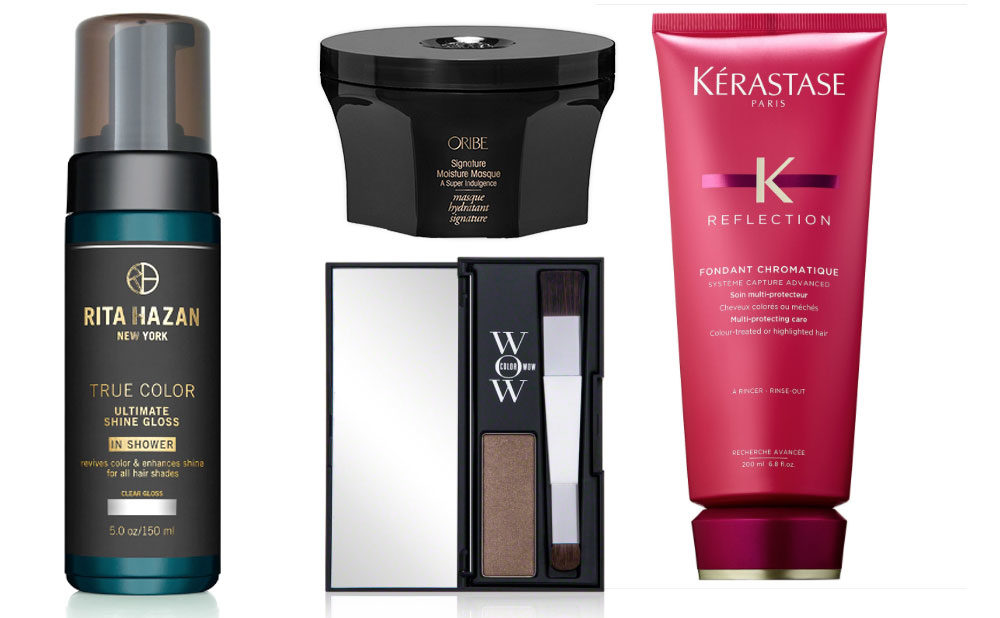
LEFT: Along with her advice to wash your hair less, Hazan recommends her Ultimate Shine Gloss (5 ounces, $26, Sephora) to prevent fading. ABOVE, CENTER: To keep your hair looking healthy at home between salon visits, Hazan suggests a weekly moisturizing mask. Oribe’s Signature Moisture Mask (5.9 fluid ounces, $63, Dermstore) enriched with fancy ingredients like Japanese bamboo and radish root hydrates, conditions and protects against dryness. BELOW, CENTER: Salon owners like fabulous colorist Jeremy Buchanan at D.C. Salon One80 advises clients to use Color Wow’s Root Coverup ($34.50, Ulta) between appointments to camouflage your roots. It adheres to hair without being sticky or oily and without looking dry. RIGHT: It’s not easy to work up a lather with Kerastase’s Reflection Sulfate-Free Shampoo for Color-Treated Hair (8.5 ounces, $30, Sephora), but it is gentle on your dry hair and preserves color.
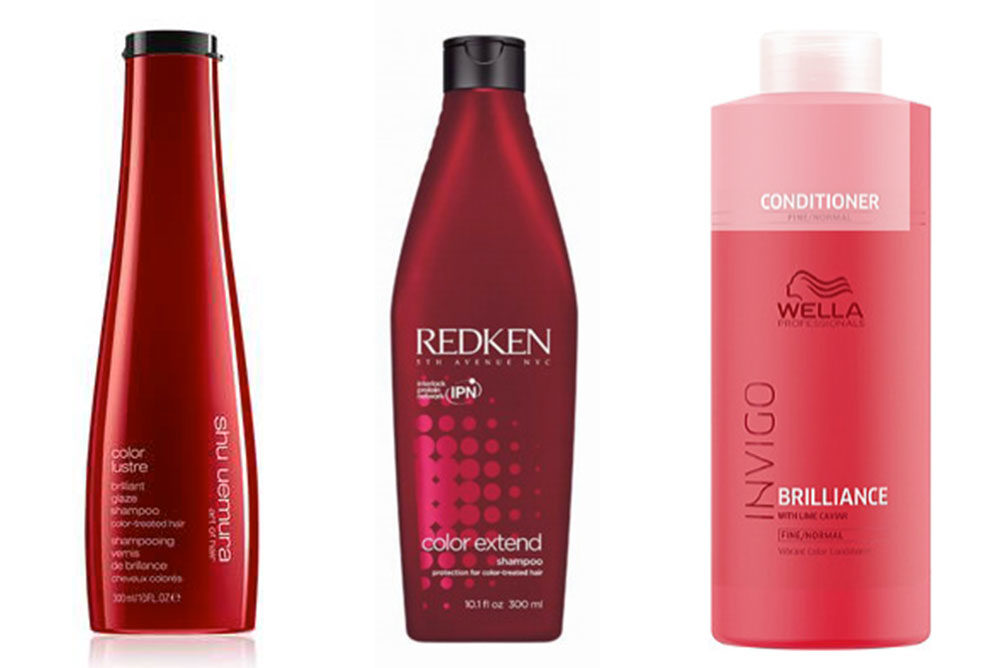
LEFT: Despite its expense, Shu Uemura’s Color Lustre Shampoo (10.1 ounces,$48, Shu Uemura) get raves from proponents. The claim is you only need a very small amount for a foamy lather. Paraben- and sulfate-free, it protects the fiber of the hair and help prevent fading with antioxidant-rich goji berry extract. CENTER: Redken’s gentle Color Extend Shampoo (10.1 ounces, $17, Ulta) helps prevent hair breakage and contains UV filters that block out the sun’s damaging rays. RIGHT: Wella’s Invigo Brilliance Vibrant Color Conditioner for Fine Hair (8.4 ounces, $12.99, Ulta), infused with Vitamin E, is a conditioner for those who want products that protect but don’t weigh down the hair.
MyLittleBird often includes links to products we write about. Our editorial choices are made independently; nonetheless, a purchase made through such a link can sometimes result in MyLittleBird receiving a commission on the sale, whether through a retailer, an online store or Amazon.com.

Photo by Casarsa / iStock
Extreme heat is everywhere this week. And, July was the hottest month ever recorded, according to the National Oceanic and Atmospheric Administration. ICYMI, here’s our previously published post on perspiration and how to cope with it.
WARM WEATHER brings the sweet fragrance of flowering trees and the mouth-watering smells of barbecue along with the less-appealing scents of sweaty body odor. Sweat is the body’s response to excess heat, whether from the sun, exercise, fever, menopause or some combination of these. Of the 2- million-plus sweat glands right under most people’s skin, women have more, but men’s sweat smells worse. How to deal with it depends on whether you want to combat the odor, skip the wet altogether or prefer doing nothing at all.
Animals pant to rid their bodies of excess heat by way of their mouths. But humans sweat from glands, transferring heat from our entire body surface. Of the two kinds of human sweat glands, eccrine glands are spread over the body, and they produce a mixture of minerals that differ depending on the person. If your sweat stings your eyes, you are a salty sweater.
But the strongest smells come from sweat produced by apocrine glands, located under the arms, around the breasts and in the groin. Some of these odors are pheromones, the “personal scent” that attracts the opposite sex, which many people find unpleasant. Even worse are odors from the sweat that’s caused by stress, which is chemically different from sweat from heat or exercise.
Sweat from the apocrine glands contains small amounts of fatty acids, which are very tasty to the main culprit of bad odors: the bacteria that live on your skin. Bacteria gobble up sweat and then you stink. Diet also plays a role: After a night of too much pasta aglio e olio and red wine, excess morning-after sweat comes with strong eau de garlic. Red meat, curry and onions also make the odor worse.
Many deodorants simply cover up bad odors with good scents, such as tuberose. Most deodorants are labeled for either men or women, and although manufacturers often use exactly the same ingredients for both, unisex deodorants make up as little as 10 percent of the market.
Some deodorants also disinfect the armpit with an alcohol base that makes the skin slightly acidic and thus less attractive to bacteria. Others contain a specific ingredient, most often triclosan, that inhibits the growth of bacteria and other microbes on the skin. (Deodorant soaps often contain triclosan, but studies have found no benefits from antibacterial soaps, either for preventing infection or for reducing bacteria.)
To combat the drip, antiperspirants have a different function: to stop sweat and thus odor by clogging the pores or ducts through which sweat pours. Most antiperspirants use some version of aluminum—lately, aluminum zirconium compounds that are less likely to cause irritation than earlier forms. Because antiperspirants alter a bodily function, unlike deodorants, they are subject to FDA regulations. To boast “all day protection” requires only that the brand reduce sweat by 20 percent; and for “extra strength,” only by 30 percent. Many antiperspirants contain deodorants.
You might be one of the lucky people whose sweat doesn’t smell at all. Alternatively, you could suffer from hyperhidrosis, excessive sweating and find antiperspirants a necessity.
While the aluminum in antiperspirants was once suspected of contributing to risks for breast cancer and Alzheimer’s disease, studies have failed to support both hypotheses. Research, however, has not solved the problem of why one person’s antiperspirant seems to lose its effectiveness after about six months, at which point brands must be switched. Neither does anyone understand what causes the yellow staining on clothes, but manufacturers are studying the “yellowing phenomenon.”
To avoid the side effects of commercial antiperspirants, from skin irritation to yellowing, alternatives can be made using various plant oils and extracts that have antibacterial powers, including white thyme essential oil, rosemary essential oil, lavender essential oil and castor oil.
Also low tech, wearing natural fabrics, which breathe more easily, reduces sweating. Wicking fabrics may soak up some of the sweat, but the remaining moisture and its accompanying bacteria always seem to smell worse. Try wearing several light natural-fabric layers instead.
In extreme cases, there is Botox, which paralyzes and shrinks the sweat glands by blocking a neurotransmitter that stimulates them. Most often used for those with hyperhidrosis, Botox is also popular with brides, grooms and prom-goers who want to avoid embarrassment as well as ruining expensive clothes. Several injections in the armpits can last up to eight months.
So you can join the Americans who spend billions per year on deodorants and antiperspirants. Or head in the other direction, toward saunas and sweat lodges, and enjoy a good sweat—even if the overpowering smell is garlic.
—Mary Carpenter
Well-Being Editor Mary Carpenter reports on news you can use right here every Tuesday.

iStock
SEVERAL YEARS ago as I was returning from Haiti, I stood in the security line at the airport, watching with awe their procedures. Because Haiti is too poor to have much of anything, certainly not the sophisticated security machinery we have in the U.S., the prevailing “security” system was two rubber-gloved men who would unzip your luggage and rifle through it, looking for something irregular. If they found nothing you were good to go.
Ahead of me on line was an elderly woman who looked as if she had spent far too much time in the sun. When it was her turn, she began to moan that she had lost the key to her suitcase. She begged the men not to cut it open because then she would never be able to get it home. They sized her up, looked at one another, called over some other airport personnel to pass judgment and ultimately let her go through, locked suitcase and all.
That memory resurfaced recently as I watched my suitcase being pulled off the conveyor belt at Dulles International Airport, where I was catching a plane home after visiting friends in rural Virginia. The young TSA inspector looked grim as he briskly unzipped my bag and started rifling through my carefully packed clothing. Assuming it was, I asked, “Is this a random search?” He shook his head no.
Ultimately seizing the offending object that had been spied on the X-ray machine, he unwrapped a six-ounce jar of peach butter I had purchased at one of those “pick-your-own” farms dotting the countryside outside of Charlottesville. I had forgotten all about the carry-on rules and stuck it in my bag, bringing it home as a gift for my son.
“I’ll have to take this,” the man said.
“But it’s just peach butter,” I exclaimed. “You can see that quite plainly.” Tightly sealed, the label on the jar boasted it was 100% organic, had no added sugar and was made from only the best local peaches.”It cost $7 and is supposedly quite good,” I added, hoping that information might win him over.
Sorry, he said. I asked if he could take it home or perhaps give it to one of his co-workers—just don’t throw it away. No, it had to be destroyed, unless I wanted to go back several steps and check the jar, then return and wait in that security line again, and maybe even miss my plane. Rejecting that suggestion, I asked if he thought the peach butter would explode. No answer, although I saw him struggle against a smile.
I boarded my plane without the peach butter, but I wondered why, unless I looked like a terrorist, things turned out that way. I’m pretty sure those Haitian guards would have let me keep it.

iStock photo.
LITTLEBIRDS Janet and Nancy are both of a bookish bent. We enjoy many of the same works, though it’s possible that Janet doesn’t find Lee Child’s Jack Reacher series as hilariously entertaining as Nancy does. There are other ways we part company: Read on!
Janet:
Last weekend, I had a glorious time with friends talking about old times, new adventures—and books we were reading or intended to. When one friend asked, more rhetorically than anything, “Who goes to the library anymore?” I was the loner among us who said, “I do.” Which got me to thinking about why—at least in my own head—I was defending that choice.
My first memory of going to the library was in elementary school. All I wanted to read was Nancy Drew books or anything by young adult novelist Rosamund du Jardin. I remember our patient hometown librarian, who tried to persuade me to expand my literature choices beyond girl-detective and romance stories.
Much later on there was the college library, where admittedly I went only when I needed to write a paper or seriously study. More often, it was because I hoped to run into a guy I liked whom I knew hung out there.
While working in NYC and later in DC, I rarely visited the library, preferring bookstores in the days of Borders. At The Washington Post, I was spoiled by the slush pile of the paper’s Book Review section, where most every week you could find a gem or two. But about 10 years ago, a comment from a colleague who said she preferred to go the library rather than buy books —hardbacks and even paperbacks were getting expensive—struck a chord. I got into the habit of going to one—first in Potomac, Maryland, and then in the Cleveland Park neighborhood of DC.
One of the first things I did when I moved to Pittsburgh while staying in temporary living quarters was get a library card at the main Carnegie Library in Oakland. It’s an impressive, massive place where you can settle into an ornate reading room, get lost in the never-ending stacks, attend a book club, borrow a musical instrument, learn a language, see an exhibit or sip a latte.
More convenient, though, is my neighborhood branch, a five-minute drive from where I eventually settled. I felt disconnected and lonely when I moved—everything was foreign. Staking out the library as familiar territory helped.
Although I only interact superficially with the staff there, I feel part of a community when I see them there most every week. There’s the tall, young guy behind the desk, who I don’t think can count very well. Whenever I bring in a book that’s well overdue, he invariably says, “That will be 30 cents” or “You don’t owe anything.” I don’t argue but I know he must be wrong because when I return an overdue book to the young woman with curly hair of multiple colors, it’s always about three times as much. I occasionally chat with her about whether she has read something I’m reading. I think, or hope, she likes her job because she never fails to smile while taking my returns and checking out my new ones. Times being what they are, there’s a security guard at the entrance. I’m not sure whether he recognizes me or not, but he always says hello, as if he does.
Another reason I love the library: for the hope of unexpected treasures you may find by just roaming around the stacks.
Sure, it’s easier and faster to download books to an electronic device, but instead of interacting with other people, it isolates us from them, locking us in our own little bubble. Libraries bring joy to so many people, including me. And I go often because I want to do whatever I can to ensure their continued existence.
—Janet Kelly
Nancy:
I love the library too, but I like to keep my distance. Part of that is because I get overwhelmed easily, just as I do in bookstores, which is why I keep away from those as well. Another part is because I’m just not very organized: If my neighborhood library closes at 5, I’ll decide I need something to read at about 5:15. Or 1 in the morning.
All of those factors send me to the library’s website where, the book gods willing, I’ll find something to download or at least place on hold. (I’m frequently met with disappointment, but this exercise saves me from Amazon, whose instant download of everything is far too tempting.)
I must once have thought that having shelves filled with books added “warmth” to my living room. Now I wonder if I was trying to prove something (that I can read?) or just set a proper “tone.”
Having just moved 35 linear feet of books from DC to NYC (that’s after donating hundreds of tomes to libraries and any charity book sale that would take them), I view their spines with terror. I think they procreate at night when I’m not watching, spreading across surfaces where dinner dishes and cocktail napkins and little bronze sculptures are supposed to sit. The fact that my new apartment doesn’t have 35 linear feet of bookshelves only adds to my distress.
I once enjoyed roaming bookstores and library stacks. At least the books I picked up from the latter went back to their shelf again; what I picked up from the former is why I still have all these books to shelve and dust. Another hazard, as Janet points out, was the book cart at The Washington Post. There was no end to the fascinating things to be found there every week. I know, because some of them are still with me, unread but still alluring.
As I was unpacking my boxes of books this week I felt a mix of feelings: oppression from their collective bulk and a sort of joy—books that I haven’t read yet even though I’ve had them for years still pique my interest. They could keep me away from the library for a very long time!
I like Janet’s idea of reinforcing community by frequenting the local branch, but I now have dozens of friendly neighbors in my co-op building and more at the various dog parks I’m learning about.
I’ll probably ask all those people what to download next, just to keep myself from being overwhelmed.
Like Janet, I really want libraries to thrive. Last week I donated to the restoration of Patience and Fortitude, the two lions that guard the main 42nd Street New York Public Library. Getting the statues all gussied up won’t save the library, but paying for their maintenance may release more money for books that I can borrow—only I hope they’ll be electronic and available to me at 1 in the morning.
—Nancy McKeon
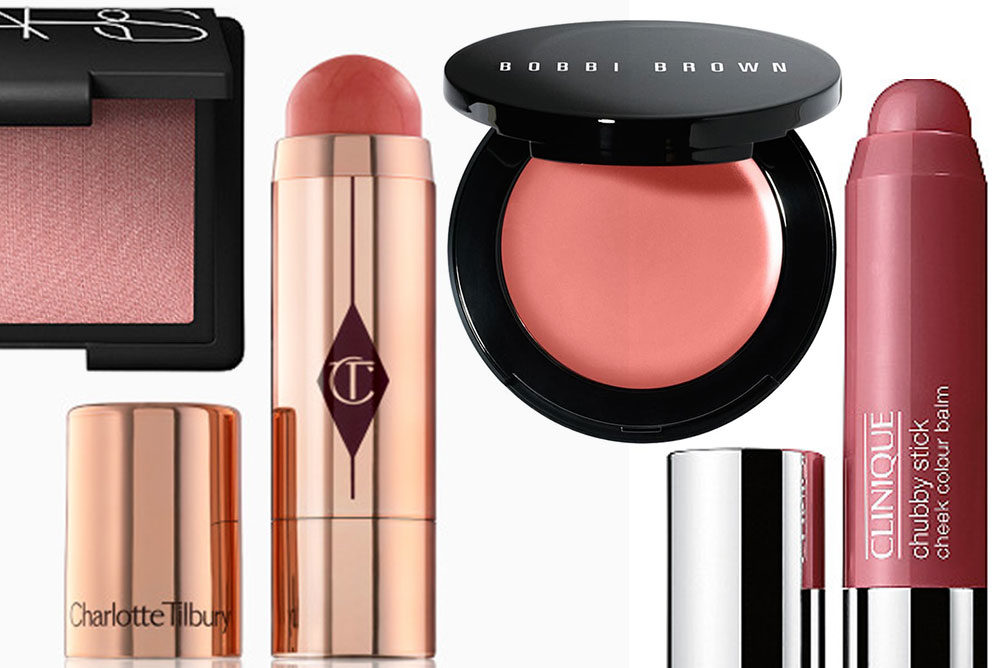
From left to right: Nars Orgasm, Charlotte Tilbury Beach Stick in Moon Beach, Bobbi Brown Pot Rouge for Lips and Cheeks in Calypso Coral and Clinique’s Chubby Stick Cheek Color in Peony.
LAST WEEK we asked readers for their blushing favorites and got nearly as many different responses as there are creams and powders on the market, which is a lot.
Stephanie Sedgwick, our brilliant Chef de Bird, said she rarely uses the stuff. That’s possibly because she keeps her head over a stock pot—the heat does bring a glow. Probably cleans her pores as well.
Several other commenters voted for Nars Orgasm, which could be wishful thinking. Powder blusher polled more popular than creams. Some moaned about discontinued favorites. One cheeky reader relies on a glass of wine to bring the color up. I’ll vote for that.
We took the most oft-asked questions to a pair of pros.
Shauné Hayes, whose clients range from Tom Hanks to blushing brides and possibly some grooms said, “My personal preference is cream blush. It brings a luminescence that looks great, particularly on mature skin. Unless powder is blended really well, it looks dry. With creams, the color appears to be coming from within, it’s more emollient, and blends into the skin better.”
Carl Ray, Michelle Obama’s official make-up artist, agreed. “Cream blush is more hydrating, making it a perfect choice for dry skin and looks great for that dewy natural fresh look.” Apply it, he says, with your fingers or a synthetic brush.
“Cream blush can also look absolutely beautiful applied on eyes, lips and cheeks,” he added. “Nars has multiple sticks that can be used for this monochromatic look.”
Both agreed with readers who said creams fade too quickly. “What I like to do is go in with a coordinating powder, just a little bit on top,” said Hayes. “I still get the luminous feel that I want, the hydrated look, but combining the two gives staying power.”
Ray agreed. “Lightly setting cream blush with a similar shade of powder blush—that helps keep it from budging.” But when dry, mature skin is not an issue he prefers powder to creams. “Powder blush is a great choice for oilier skin. Apply it sparingly—you can always add.
Ray, who prefers shades from Makeup Forever, Dior, Anastasia Beverly Hills and MAC, added: “Powder blush gives a sophisticated, polished look and is more widely used by makeup artists.”
But, he cautioned, “it can make skin look and feel more mature than it actually is. Let’s face it—caked-on makeup is not a good look.”
Hayes, who often uses her fingers when working on her own face, has a hands-down favorite in cream blushers from Bobbi Brown. “It’s the ease, emollience and the payoff,” she said. “The color goes on as bright or soft as I need it to be. It can go from sheer to POP. It’s also multipurpose—you can use on your lips for a little color.”
For the fumble-fingered, she suggests trying color in a tube. “Clinique makes a chubby stick as does Charlotte Tilbury. Just put a dot on your cheek and blend. It’s easy to carry in your bag and refresh throughout the day.
Picking your perfect color can be tricky. For a natural look, think about your skin’s undertone and choose a shade of blush with a bit more oomph.
“The best way to determine your undertone is to look at the veins in your wrist under natural light,” said Ray. “Do they look slightly green? If so, you’re warm. If your veins have more of a blue tint or even a hint of purple, your undertones are cool. If you see a mix, then you may have neutral undertones.
“Grab a pure white piece of clothing or even just a piece of white paper. In bright, natural light, hold the item up to your face. If your skin looks pink or rosy by comparison, you’re cool toned. If your face looks more yellow, your undertone is warm. If you feel you look better in off-white or creamy hues rather than stark white, that’s another sign that you may be warm toned. If you can wear both colors without feeling like you look washed out, you may have a neutral undertone.”
In general, those with very fair, alabaster complexions, with blue undertones, look best in shades of baby pink, said Hayes. “If your undertone is more yellow, peach can be very flattering.”
Medium skin needs a little more warmth. “Apricot can be very warm and subtle,” she said. “You already have color, so we just want to accentuate it ever so slightly.”
Dark skin “can really hold the pigment,” she said. “Bright colors can look amazing… deep raisin, terra cotta or brick looks gorgeous on dark skin.” Watch out for colors that look ashy though, or those that make you look ruddy or muddy.
No matter your skin color, “Don’t be afraid to go bold, but blend it well,” she said, a caution she repeated many, many times. Hayes prefers a foam wedge for its ability to soften edges and make that blush look like yours, but better.
Bobbi Brown, Tilbury, and Clinique are on the pricey side, but you needn’t spend a fortune to get a great look and performance. “Often there’s not enough difference—or none at all—to justify the price,” she said. “A lot of brands are owned by the high-end companies, and they just repackage the product.”
Hayes likes L’Oréal, which also owns Lancôme, Saint Laurent, and Armani beauty products, but also–straight from the drugstore aisle—L’Oréal’s Visible Lift Color Blush, which costs less than ten bucks. Sadly, that one’s discontinued, but their True Match Super Blendable Blush claims to give a natural flush—and coordinates with their powders and foundations.
I happen to love Wet n Wild, another drugstore staple. They make powders in a great range of shades, including a ringer for Nars Orgasm. Even better are their creamy sticks in colors that range from pale pink to darkest brown that are excellent for giving subtle color and contouring, all for under $5 each.
Speaking of contouring.
The right shade of blush can slim a nose, sculpt a cheekbone and make the jaw a little less jiggly (looking). There are a million tutorials online. “Look for a brown without any red, which looks like it’s sitting on the skin,” says Hayes. “When you want areas to recede you want a cooler shade, like taupe, which defines while looking natural. And no shimmer, which highlights.”
Just make sure you blend and blend and blend and…
—Stephanie Cavanaugh
When not messing about with plants, Stephanie Gardens likes to tinker with beauty products and makeup.
Now, some thoughts from some of our staff and readers:
Cindy Tilson
I use Nars Mata Hari, a powder blush. This one is applied differently than most blushes are, though. It’s a shocking, almost fluorescent pink! It’s to be applied very sparingly with a large brush, just lightly dusted high in the center of the apple of your cheeks, just under your pupils. Caution: apply too much and you look like Betty Davis playing Baby Jane Hudson. Apply just enough and you look fresh, glowing and instantly younger.
Carol Lichty
I have pretty much always used drug store makeup but I do like Clinique, too. I checked my blushes and I have one Revlon and one Neutrogena (pinkish mauve flavors). What I do know is that my good makeup brush is indispensable and goes with me always. The little brushes that come with blushes are pretty poor applicators. And, yes, I agree that cream blush doesn’t work for me either.
Linda Kastan
I am a powder blush fan. I can’t seem to put on cream without looking like a clown. I have been liking YSL (I like most things French), good colors and consistency, but I also happen to know someone at a store in Dublin who sends me YSL at a discount. Right this moment (actually just a few days ago), I went back to Nars Orgasm blusher. Very summer natural. I don’t often experiment with new brands—well, sometimes I do—but not lately. By the way, the cheek color I get from a glass of red wine often works just as well.
Judith Robinson
Laura Mercier’s Rose Petal was my favorite. But, of course, the old, sad story: discontinued! However, I begged a saleswoman at Bloomingdale’s in NYC to sell me all her testers, which were inserts for tiny compacts! I got about a dozen, now down to the last one and a half. So far, I haven’t found any more.
Kathy Legg
I use two Lancôme blushes. Powders. One a rosy pink, the other more on the neutral side and vary them depending on the color lipstick I’m wearing (either rosy or orange-ish). I’ve tried the cream blushes, and I swear they just sink into my skin and disappear, so I stick with powder. Sometimes it doesn’t seem to last long either. I must be doing something wrong. I just looked on Lancôme’s site, and my colors no longer are featured. Guess it’s been a while since I bought blush.
Nancy McKeon
Kathy, I was waiting for your input! You more than anyone I know can wield a blush brush brilliantly (say that three times fast). You really transform a daytime look into something much more glam. Maybe it’s not so much about the blush as your sure hand in contouring. It looks great when you do it—not theatrical, just good.
Kathy Legg
I do nothing special. Just try to get it on before the dogs knock the brush out of my hand. Seriously.
Ada Polla
Orgasm by Nars is a classic, and the best in my opinion.
Janet Kelly
Burberry discontinued my favorite blush in hydrangea. It was a cross between a powder and a cream and blended so nicely. Oh, well. Now I’m using Westman Atelier’s Super-Loaded Tinted Highlight, which does last a long time but is a little intense. I’m tempted to try the brand’s Baby Cheeks Blush Stick in Poppet because it looks a lot like the old Burberry color. In the meantime, sometimes I just use lipstick as a blush.
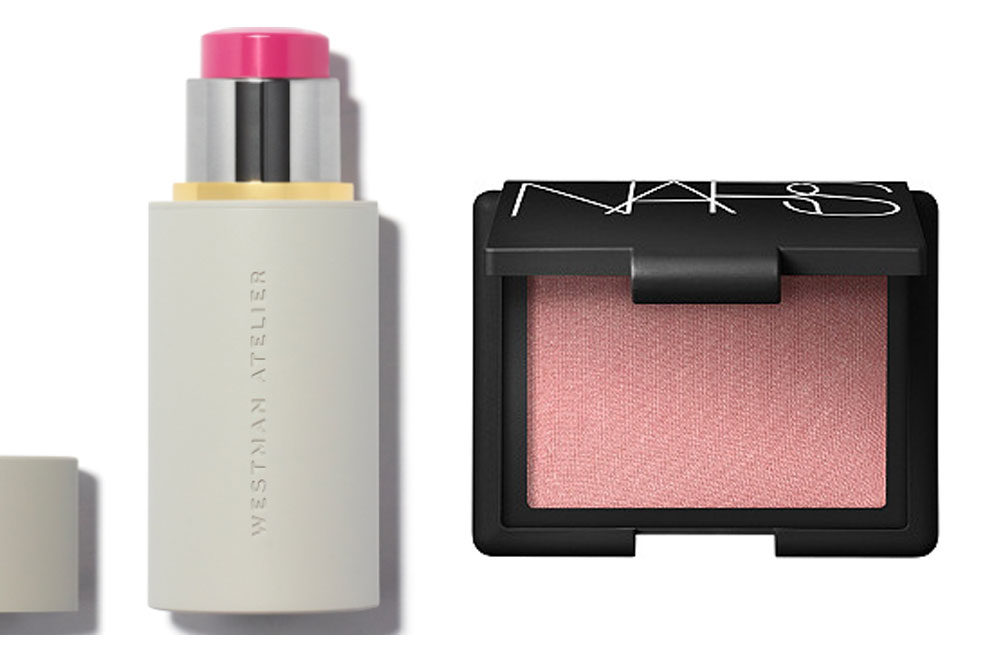
LEFT: For creamy blush fans, Westman Atelier’s Baby Cheeks Blush Stick ($50, Violet Grey) is a multi-tasker for velvety color for cheeks, lips and lids. RIGHT: Nars Orgasm ($30, Ulta) has a devoted following among makeup artists and the rest of us.
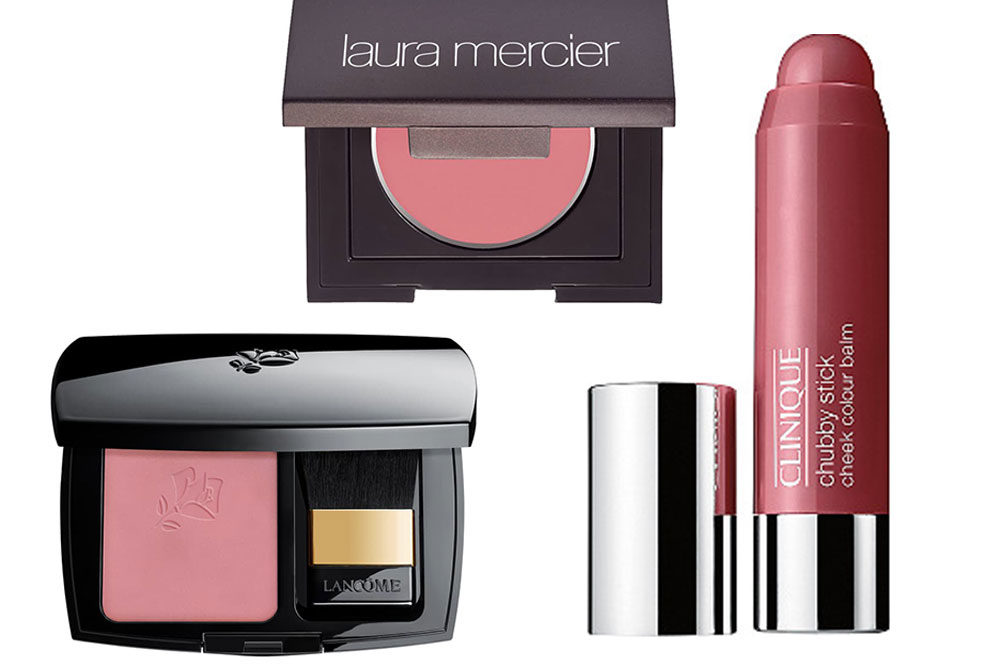
LEFT: The colors of Kathy Legg’s preferred Lancôme’s powder blushes have been discontinued. When she wants to resupply, she’d choose the label’s Blush Subtil Oil-Free Powder Blush in Rose Fresque ($32, Nordstrom) CENTER: Maybe Judy Robinson could be persuaded to try another shade of Laura Mercier blush, such as this Crème Cheek Color in Oleander ($29, Nordstrom). RIGHT: Chubby Stick Cheek Colour Balm (shown in Plumped Up Peony, $25, Ulta) is a quick, no-fuss, dot-and-blend solution for the impatient among us.
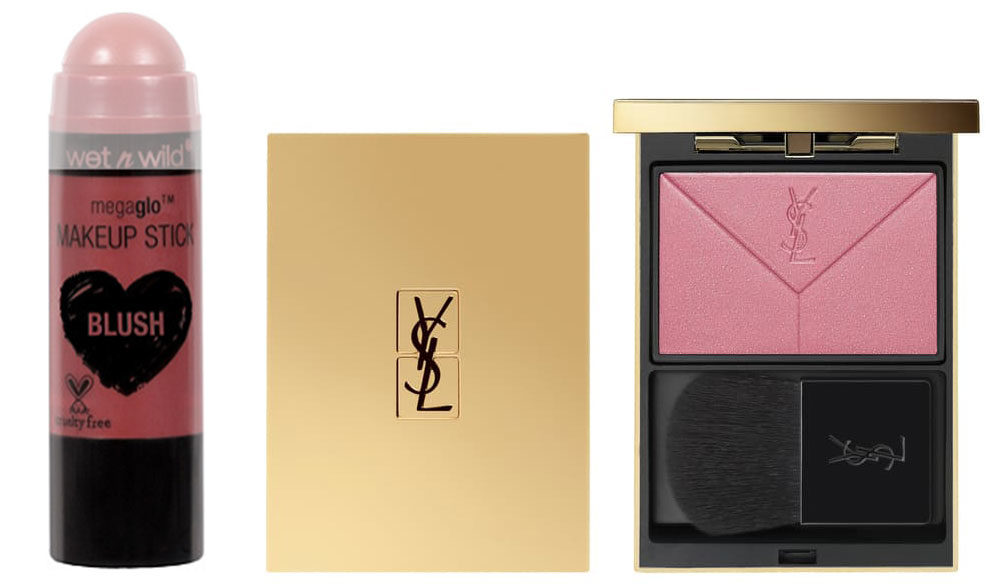
LEFT: Stephanie Cavanaugh stands by drugstore staple Wet n Wild’s Megaglow Makeup Stick Blush ($4.29, Ulta) for subtle color and contouring. RIGHT: A powder-blush fan, Linda Kastan’s go-to is Yves Saint Laurent’s Couture Blush ($42, Nordstrom).
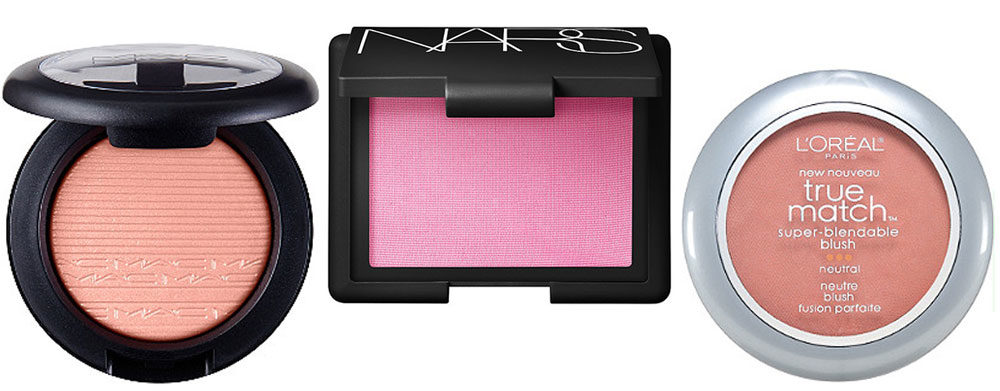
LEFT: Can’t decide between a cream and a powder? MAC’s Extra Dimension Blush ($30, Ulta) combines a cream’s blendability with the finish of a powder. CENTER: A little Nars powder blush in Mata Hari ($30, Bloomingdales) goes a long way. Apply sparingly. RIGHT: True Match Super Blendable Blush ($11.99, Ulta) replaces L’Oreal’s discontinued Visible Lift Color Blush.
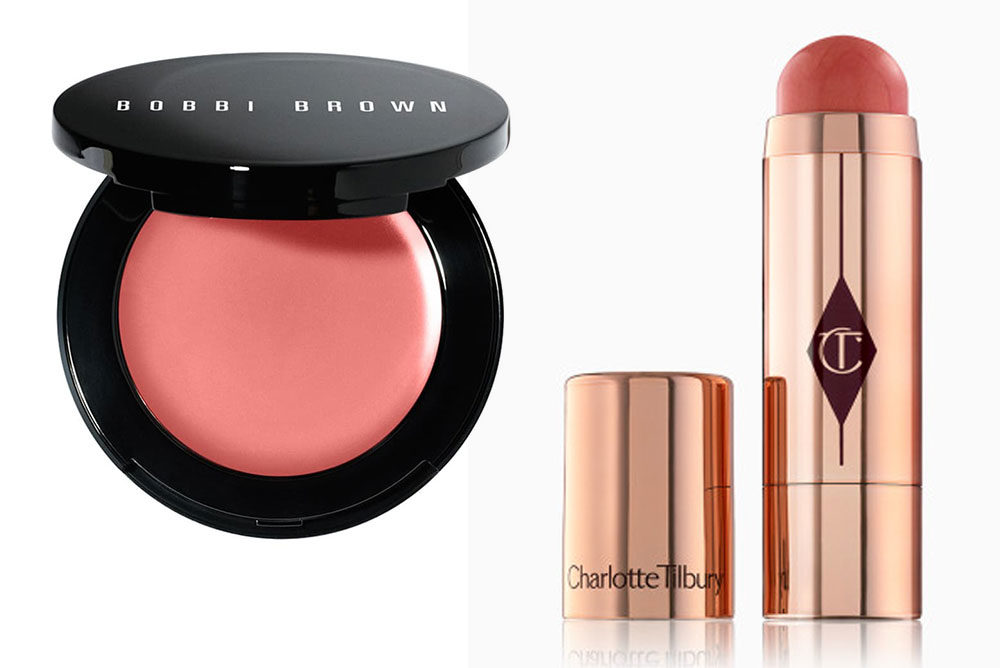
LEFT: Makeup artist Shauné Hayes likes Bobbi Brown’s cream blushers, like this multitasking Pot Rouge for Lips and Cheeks ($33, Nordstrom). RIGHT: For the fumble-fingered, a chubby crayon, such as Charlotte Tilbury’s Beach Stick ($45, Charlotte Tilbury), does the trick.
MyLittleBird often includes links to products we write about. Our editorial choices are made independently; nonetheless, a purchase made through such a link can sometimes result in MyLittleBird receiving a commission on the sale, whether through a retailer, an online store or Amazon.com.
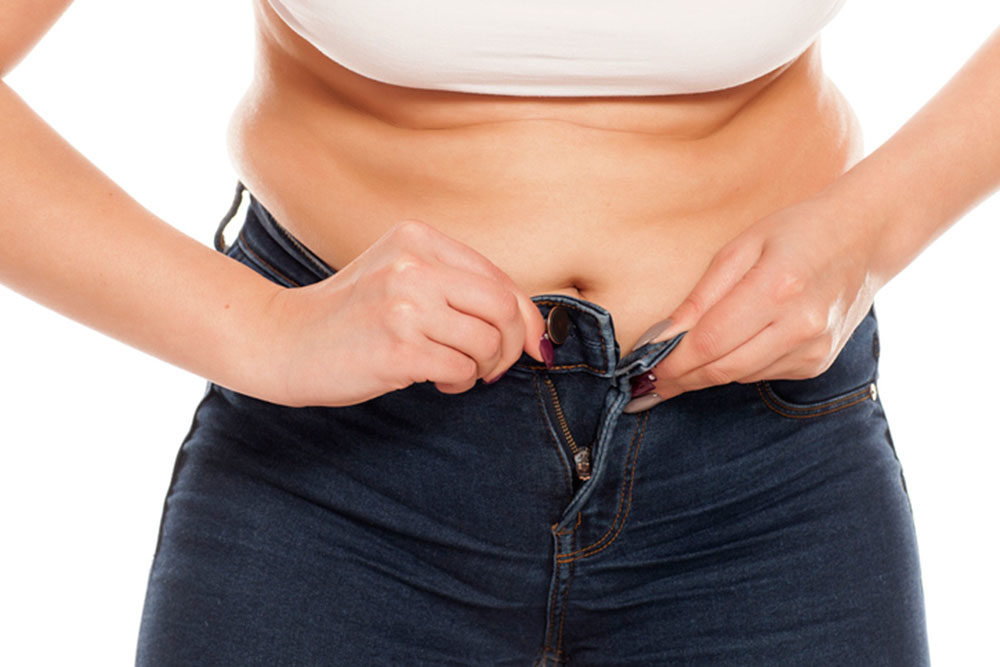
iStock
AIN’T LIFE grand? Not only can I get a brand spanking new artificial hip installed after totally destroying the one God gave me, I can now eat whatever I want without getting fat, thanks to an amazing procedure called CoolSculpting with Zeltiq. Devised by Harvard scientists, you know it’s got to be good.
I never heard of it until I read the ad in our local paper about a non-surgical, non-invasive and 100% natural way to lose those annoying bumps and bulges of stubborn fat. (It supposedly targets stubborn fat, and really, isn’t that the worst kind?) The ad says if your jeans are too tight and exercise isn’t helping and you hate dieting, this is just the ticket; that all you have to do is lay back and let the doctors at Skin Solutions work their magic. How cool is it that? Of course I called right away—I’m no dummy—and asked to learn more.
The lady on the phone helpfully explained that they “suck the fat into a vacuum.”
“A vacuum? Exactly how do they create this vacuum?”
“It’s sort of like a vacuum cleaner,” she explained.
“Oh,” I said. “You mean liposuction?”
“No, this is completely different! With liposuction the tube goes into your body, but this one stays on the surface for like half an hour to two hours, depending on how much fat you need to get rid of.”
“Well, then what happens?”
“It, like, freezes the fat and then, like, sucks it in,” she said.
It sounded so simple, I was amazed I hadn’t thought of it myself. I was all set to make an appointment until, a moment later, I found an ad for losing inches “quickly and painlessly, with no recovery time” using Zerona, a laser treatment that opens the pores in your fat cells, letting the liquefied fat pour out into the space around the cell. The fat is then flushed out through the lymphatic system. That sounded so sensible, I wondered if Zerona might be even better than Zeltiq, so I called them. A recording said the office was closed and in a medical emergency to please call 911, and if it was an emergency that required talking with either of the two doctors, a husband and wife team, to just leave a message and one of them would call back very soon. And even if it wasn’t an emergency, one of them would still call back very soon.
Seems easier to just buy bigger jeans.
—Andrea Rouda
Andrea Rouda blogs at The Daily Droid.
LAST WEEK, in Newton, Massachusetts, a biker of the peddling sort noticed a baby raccoon stuck in a sewer grate. How it got there is anyone’s guess, but it took two hours, seven firemen, a veterinarian, a dousing with shampoo, constricting with dental floss and a tranquilizer gun to unplug him or her. The sex of the raccoon was not mentioned.
The story appeared in the Washington Post online and a host of other illustrious news sources on what must have been an extremely slow news day.
This is neither here nor there, however.
As it happened, this was on the very same day that I was contemplating the latest rig My Prince had installed to keep our personal raccoon out of the damn pond and away from his precious feeder fish which, as I’ve explained numerous times, are the fish you buy 10 for a buck to feed your anaconda—but look attractive enough when they’re alive.
When we last left the pond, however, the fish were tragically floating on the surface.
That time, their demise was for mysterious reasons, which distressed my beloved no end, particularly because there was no way he could blame me. A week or so later, he moped off to Petco or PetSmart or what-not and adopted new ones.
The latest batch are just starting to respond to his voice, darting up to the surface of the little pond searching for crumbs of food. My Prince just glows at the attention. Not like he’s not bribing them or anything, oh no.
Then, several disappeared in the night. As the plants and stones were in some disarray, we figured the Procyon lotor (to get Latin about it) was back. Further proof: distinctly raccoon-shaped footprints on the white porch sofa cushions. Sushi always makes him (or her) sleepy.
A rummage in the garage brought forth a dark green milk crate, which my warrior set upside down on the pond floor. In theory, the fish are small enough to dash into the holes and hide if the midnight marauder returned, or so he thought.
This is an extremely unattractive addition to a pond that I’ve been trying to make seem a natural and sylvan little glen, or as natural as a kidney-shaped black plastic tub can be. Its flagstone rim is bordered with ferns and caladium, jasmine and moss, and the occasional (when I’m feeling flush) orchid or three. The amethyst crystal at the headless statue’s base is recharging.
It is my personal homage to the US Botanic Garden’s delightful little orchid chamber, which features a pond with a cunning log bridge and ferns and orchids and such. Theirs is somewhat more successful than mine—though I do have more birds and butterflies flittering about.
Clearly, the milk crate doesn’t fit in with the vision; you have to stand back a few feet and not look straight down. Just assume there are fish.
Plants! I thought, cover it with plants.
Heading over to Gingko Gardens, our local gardening emporium, I picked up a few water hyacinths, which I was told would flower and multiply even in the spotty sunlight the pond receives. As I’ve trod this very path before, I know this to be an untruth, but I chose to believe. . . .
These were tucked in the holes of the crate, the fantasy being that they would multiply and cover the unsightly rig. Unfortunately, the raccoon finds them nearly as tasty as the fish. I imagine him (or her) plucking them with his (or her) scary little fingers and sitting among the ferns to munch and contemplate the crate.
Yesterday, I wandered out with my morning coffee to see if my plumeria had done anything interesting (of this I’m beginning to despair) and found the crate tipped over, shreds of dead plant life strewn across the pond’s surface—and several more fish had ascended to heaven.
The crate is now back in place, white letters spelling out RECYCLE in bold type, topped with several rusted iron bars, and a conch shell which I suppose is an attempt at decoration. This fails.
Perhaps a tasteful mat of plastic shrubbish might be wired to the crate top. Best get to it soon, otherwise My Prince will be breaking out the barbed wire. A garden pond is such a lovely thing.
Maybe plastic fish?
—Stephanie Cavanaugh
LittleBird “Stephanie Gardens” finds urban wildlife adventures every time she strays out back.
I AM NOT a fan of the bare-shoulder (cold-shoulder) trend that became popular a couple of years ago. It may have its place in steamy, hot weather or for evening wear but what about in frigid air-conditioned spaces? Do you cover up exposed shoulders with a wrap or just freeze for the sake of fashion? It has the same appeal for me as wearing a strapless bra. Uncomfortable and always on the alert for slippage. The look seems to be, er, cooling off, although one-shoulder pieces are still going strong. As for those voluminous dresses and blouses with ruffles and froufrou flounces, more manageable styles have shown up, allowing you to eat without having your clothing look like your lunch.
Instead of overwhelming you, shoulders puff out, while sleeves gently pouf. The effect is similar to shoulder pads—remember those? One of the nice things about the emphasis on shoulders and sleeves is that it draws the eye to our smallest body part—our waistline. Moreover, the silhouette looks new and fresh, which justifies a wardrobe addition or two.
Note that stand-out sleeves should be balanced with an unfussy silhouette, such as slim pants or slightly flared skirt hemlines. New dresses and blouses come in all price ranges and materials—from a a Something Navy crewneck T-shirt to a metallic, pleated, over-the-top, Elizabethan-like blouse from Rodarte. Below, some suggested additions to hit the refresh button on the last weeks of summer.
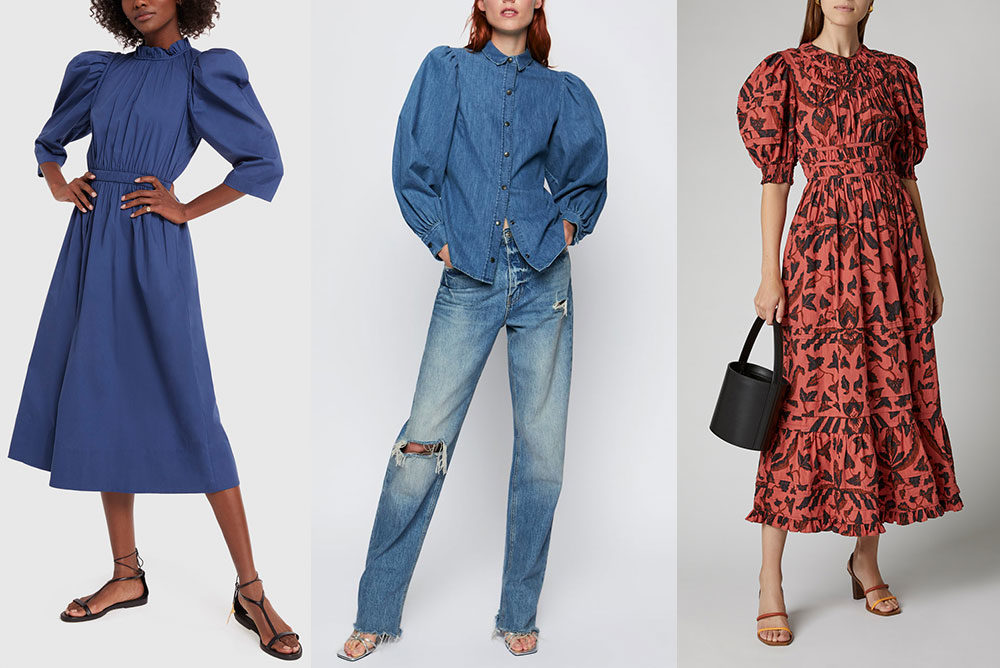
LEFT: Sea’s Luna Corded Puff Sleeve Dress ($395, Shopbop), made of stretch sateen, is the kind of thing you can wear for multiple occasions and not be bored. The pretty details—ruffled neckline, puff shoulders and buttons along the back—combine with the practical cinched-elastic waistline. CENTER: I’ve been eyeing Zara’s Balloon Sleeve Shirt ($69) for several weeks now. The sleeves are slightly fuller than I’d like, but still it’s a fun, new take on an old wardrobe reliable. I just hope it doesn’t sell out before I push the button on it. RIGHT: Wearable right now and into the fall, this Indah Printed Cotton Maxi Dress ($445, Moda Operandi) is made by artisans in India. Sometimes Ulla Johnson’s clothing gives off a too-crafty vibe, but not in this instance. The lush-looking leaf print is available on an orange or navy background.
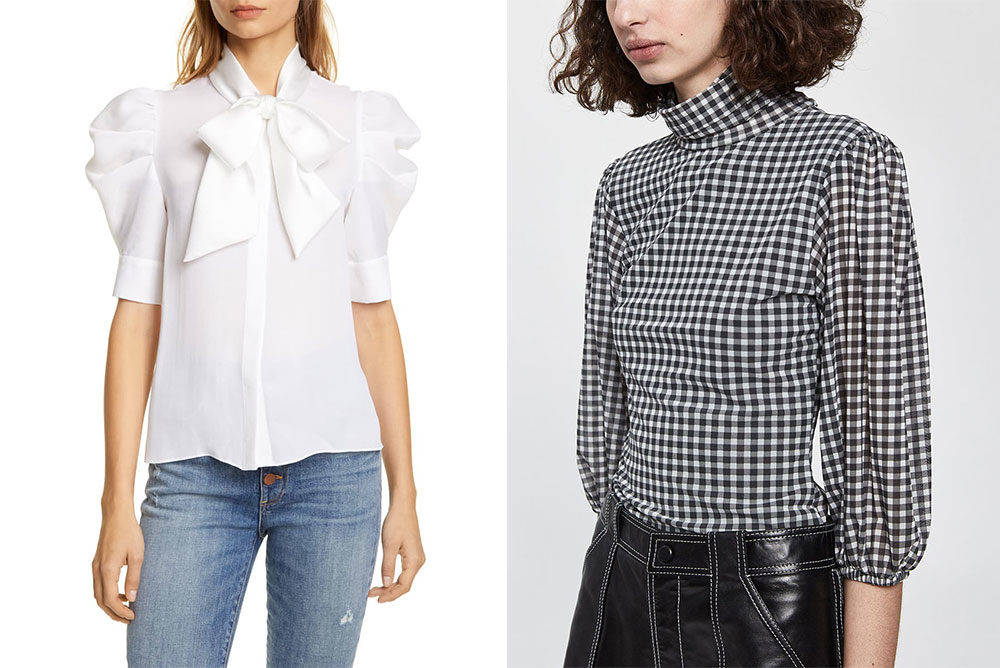
LEFT: Alice + Olivia‘s silky Maylee Tie-Neck Blouse with puff sleeves says prim but with attitude. Take even more of the starch out of it by wearing with your favorite jeans. $350, Nordstrom. RIGHT: Danish designer Ganni gives a turtleneck a fresh look with a fitted bodice, lightly padded shoulders, sleeves with elasticized cuffs and a semi-sheer back. The Mesh Check Puff Sleeve Top is $145 from Need Supply.
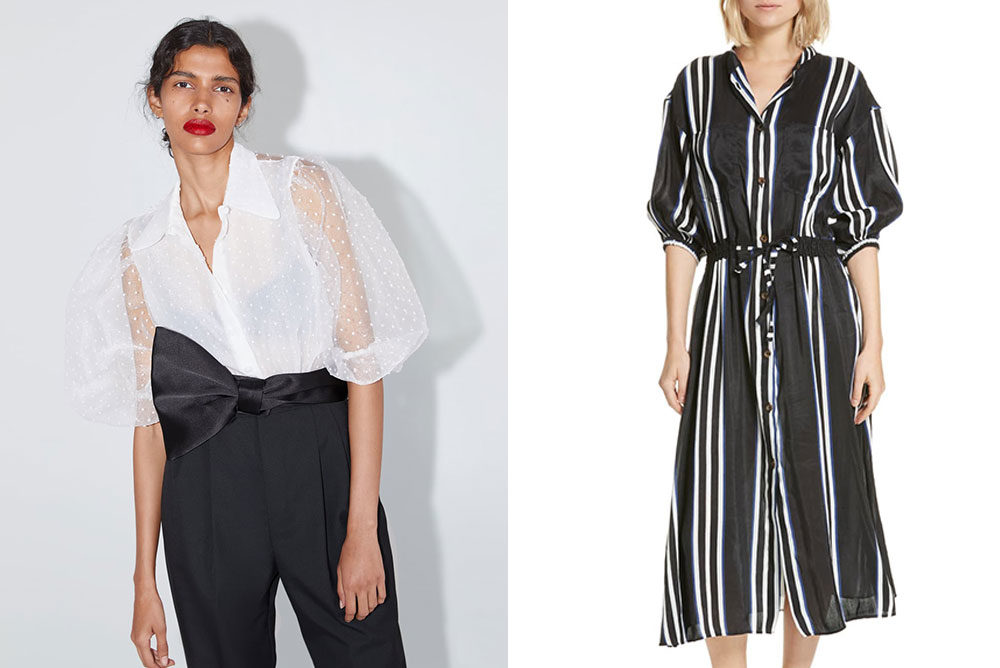
LEFT: I can see wearing Zara‘s dotted appliqué Organza Blouse with Full Sleeves ($49) with a pair of satin pants for a black-tie event or just a swank evening out. RIGHT: Apiece Apart‘s linen-and-silk Shirtdress (reduced to $296.48 from $495, Nordstrom) takes a softer, relaxed approach to the traditionally tailored classic.
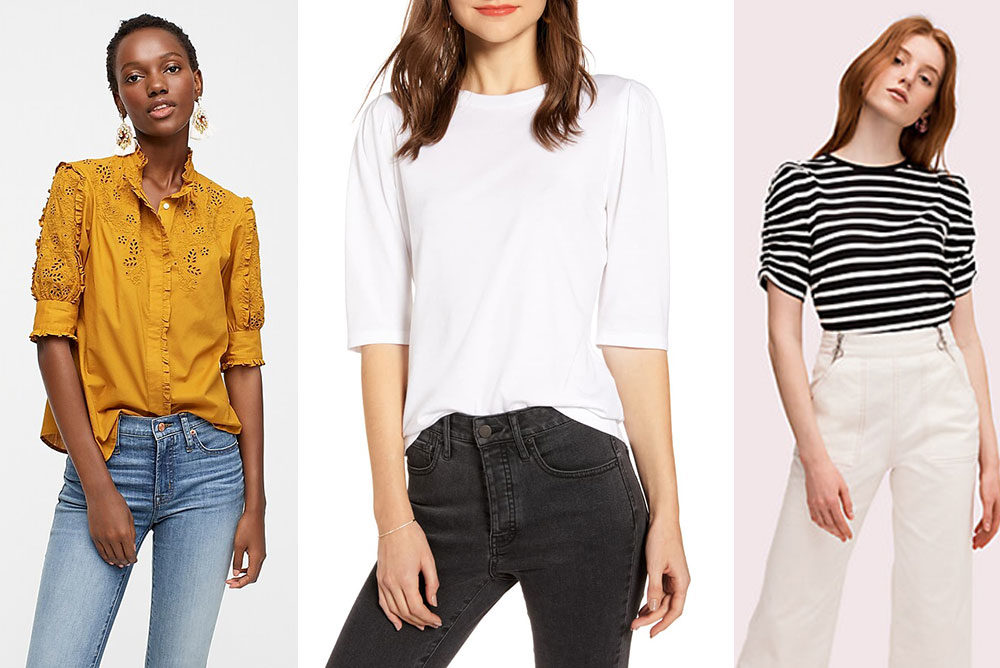
LEFT: Embroidery, ruffles, defined shoulders and elbow-length sleeves set J.Crew‘s Mockneck Embroidered Blouse ($79.50) apart from an ordinary button-up. Also available in white and black. CENTER: Gently puffed shoulders and three-quarter sleeves turn a crewneck T-shirt into a fresh staple, ready to wear now or in any season. Something Navy’s Puff Sleeve T-Shirt ($45, Nordstrom) is available in heather, black, olive, white or pink. RIGHT: It’s hard to go wrong with a French sailor shirt, à la Coco Chanel. Kate Spade New York’s Sailing Stripe Tee ($88, Bloomingdales) updates it with stylishly scrunched sleeves.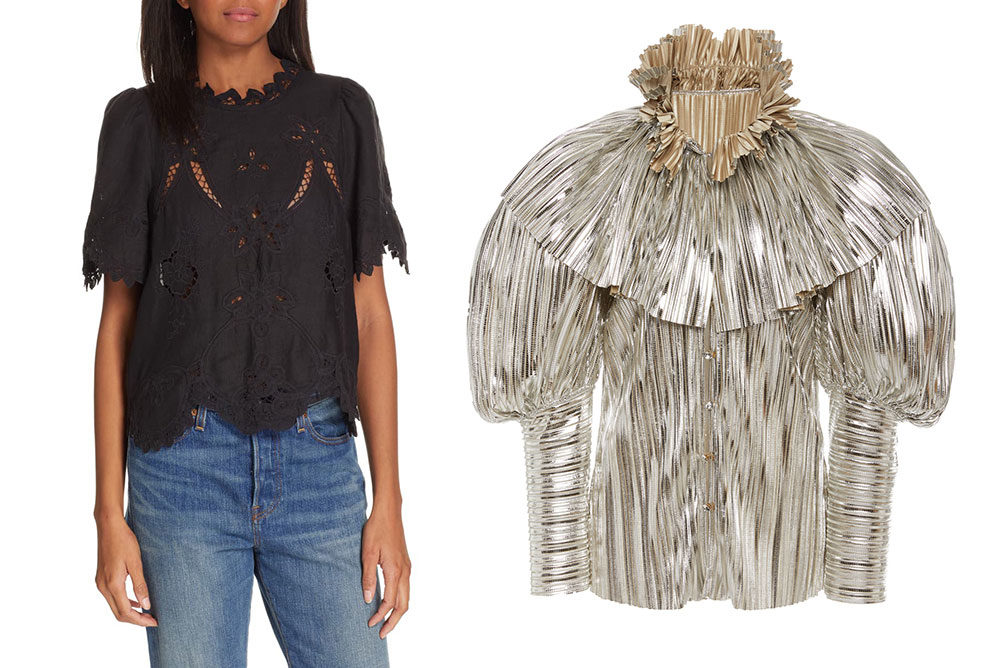
LEFT: Romance is always in fashion. And Rebecca Taylor’s Terri Embroidered Linen Top is on sale, too (reduced from $395 to $236.98 at Nordstrom). This linen-eyelet top with slightly puffed shoulders, scalloped trim at the collar, cuffs and hem, spells sweet and feminine. RIGHT: Whether to wear it or display it is the question, as it often is with Rodarte. But if you happen to have the budget of a one-percenter, you can take your choice with this Metallic Plissé Lamé Top ($2,245, Moda Operandi). Inspired by Elizabethan era styles, Rodarte’s blouse has a cascading bib, puffed Juliet sleeves and a fluted collar. In case you’re interested, the matching wide-leg pants are $2,070.
MyLittleBird often includes links to products we write about. Our editorial choices are made independently; nonetheless, a purchase made through such a link can sometimes result in MyLittleBird receiving a commission on the sale, whether through a retailer, an online store or Amazon.com.
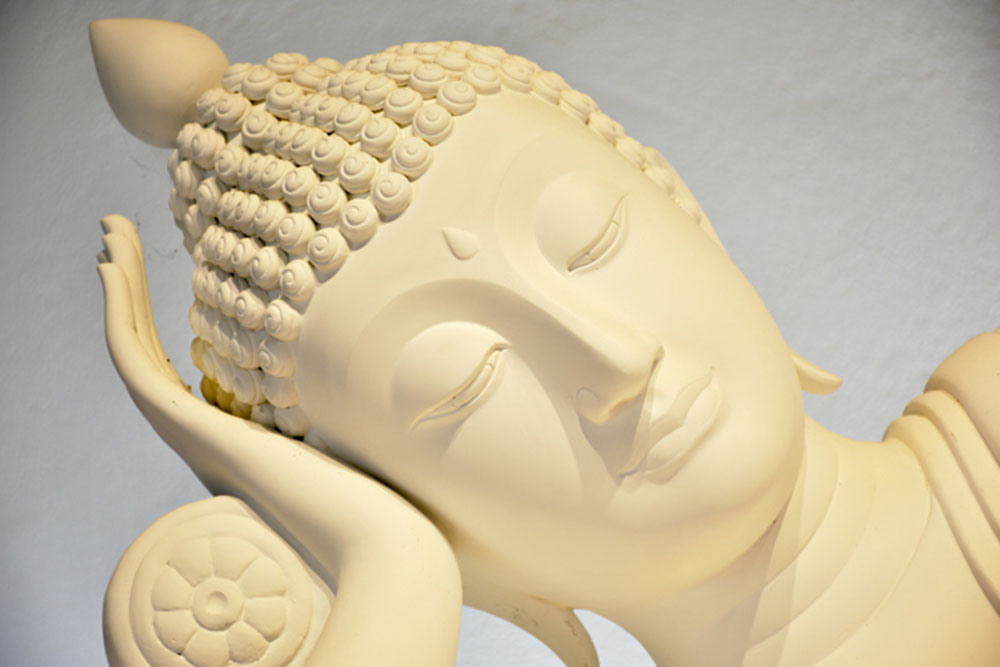
iStock
MEDITATION IS so in right now. That and yoga. And eating yogurt with probiotics for a healthy digestive tract. And suddenly it is very important to be mindful. Mindfulness is definitely in. Wanting to be in, and wanting to be mindful, yesterday I bought a magazine called Shambhala Sun and read it cover to cover, in the hopes that I might speed up my transformation to a more mindful, more digestively healthy self.
I felt at a slight disadvantage as I have no idea what shambhala means. Nevertheless I read an article called “A Meditation Instruction” by someone named Chogyam Trungpa, with those two little dots over the “o” in his name, and he made it all sound so simple. In a nutshell, you just breathe in and then breathe out, and pay attention to your breathing, and you’re doing it. That’s meditation. Oh, and you should be sitting down while you’re doing it, and do it every day at a specific time, for like 20 minutes. Fine, I can do that, I thought. How exciting—a whole new me is within my grasp just from breathing in and breathing out; who knew?
But the deeper I delved into this magazine, the more it seemed like any other magazine in that’s filled with advertising, in this case targeted for aspiring Buddhists. You can buy shrine materials. You can buy prayer beads and meditation cushions. (I believe those cushions are just like any cushions, but when you sit on them while meditating they become meditation cushions.) There were several ads for incense and bells and gongs, although those must come later because the article I read did not say one thing about a bell or a gong, or even a cushion for that matter. Chogyam made a point of saying sit anywhere, but sit up straight. Actually he said to “sit with the posture you would use if you were asking your lover to marry you,” which is odd since usually that’s on bended knee, but I digress.
There were ads for mindful psychotherapists, and who the heck would want any other kind? You can find Buddhist real estate brokers. There was an ad for Divine Buddhist jewelry that looked like normal jewelry but it had Indian writing on it and also little Buddha charms. There were many ads and coupons for meditation retreats and seminars and meetings and conventions, where I could pay handsomely to sit in a large group of people and engage in quiet self-reflection, which is somewhat confusing because the article I read said that all meditation is done alone. (I will have to re-read that article.)
The bottom line is that all of this will help me achieve Oneness With the Universe, something I desperately would like to experience for even five minutes before I die, since I always feel such Opposite of Oneness With the Universe. Meditation can help me learn how to find joy in every breath! To seize the moment! To live life fully! In fact, Living Fully is a book that I can buy right now that will help me do that. I can find my soul mate and share my dharma, whatever that is, at dharmamatch, “where spiritual singles meet.” There is an ad for a Buddhist astrologer and another for a “focusing session” on the phone with a Zen priest who had eight years of training in Japan. There are so many new and exciting ways to spend money: Buddhist prayer flags, Dharma sculptures, guided meditation CDs.
Or I could just go sit in a dark corner in my living room and light a candle and breathe in and out for free. I’ve got half a mind to do that.
—Andrea Rouda
Andrea Rouda blogs at The Daily Droid.
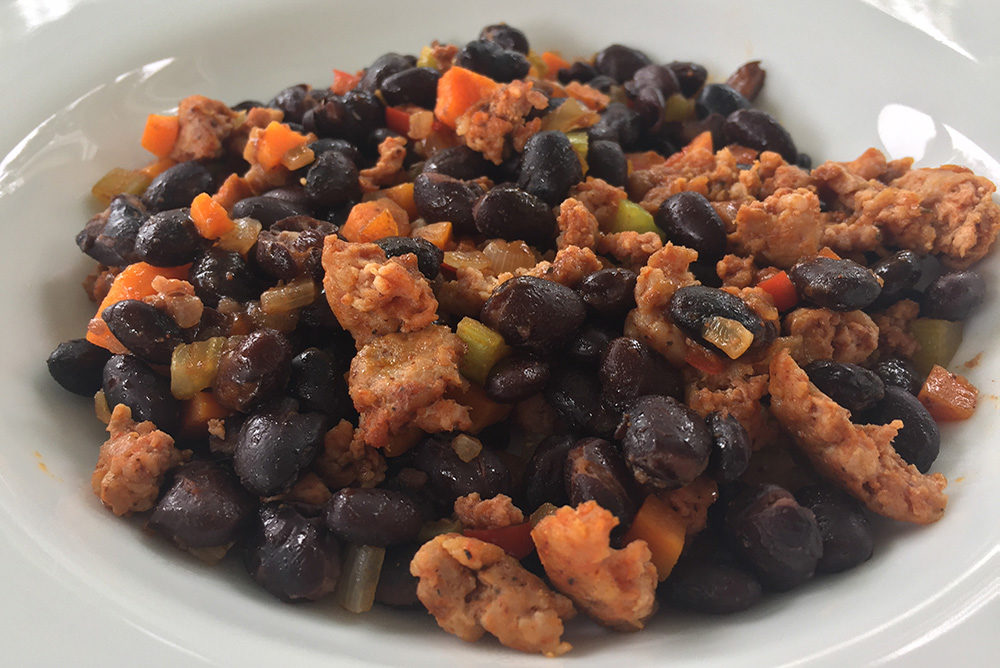
Black beans and sausage. / Photo by Stephanie Witt Sedgwick.
AT THE START of my food writing career I was a bean hater, not an attribute I was particularly proud of. A week into my first job at the Washington Post Food Section, I was tasked wth testing a Black Bean Paté from the menu of a hot-hot-hot Adams Morgan brunch spot. The thing that wasn’t so hot-hot-hot was my enthusiasm for this dish.
The recipe turned out just fine, but I couldn’t believe the result was really what the chef had in mind. I called and asked if I could stop by the restaurant to see his version. As you can probably predict, there was nothing wrong with his recipe, or his dish—the problem was all me.
Embarrassed by the whole incident, I decided to put aside my instinctive distaste and try to like beans. In no time, I did a complete 180. I love beans: cannellini beans with sautéed greens, white northerns mixed with chunks of pork or beef in a stew, black bean salsa, mixed bean salads and more.
It’s been a great turn-around as not only are beans on the good-for-you list (I love when that happens) but canned beans are an easy item to keep in the pantry for last-minute meals. I make bean salsas to spoon over grilled meats in the summer, bean salads to take to potlucks, and bean stews during the winter, because in addition to bringing texture and helping cut down on the meat, the beans naturally thicken the stew. Sometimes I start with dry beans, but I most of the time I rely on the convenience of canned beans. One thing I still can’t quite come around to is the black bean paté, but luckily there are so many other options.
Black Bean Tropical Salsa: Mix rinsed canned black beans with diced pineapple or mango or a combination of both, add any fruit juice that has accumulated on the cutting board. Add some combination of diced red or sweet onion, diced jalapeño, diced red bell pepper, and a spoonful of honey and a tablespoon or two of olive oil. If you have fresh herbs such as cilantro or parsley, go ahead and chop some up and add; if not, no big deal. Season with salt and pepper. Spoon the salsa over sliced grilled pork loin, chicken breast or turkey tenderloins. Or just eat as a side salad.
Black Bean Salad Primavera: I love the term “primavera”: It can mean whatever combination of vegetables you like. I’m partial to diced celery, carrots, bell peppers, sweet onions and corn with black beans, but you could add diced zucchini or even winter squash; just cook the cubed squash until tender before adding. Add some apple cider or white-wine vinegar, olive oil, salt and pepper and mix to combine. Once again, chopped fresh herbs are nice but not necessary. Chopped fresh chilies can add a nice kick if you have any on hand.
Black Bean Sauté: This is a go-to meal for me. Take leftover grilled or roasted chicken or pork and dice it up into bean-size cubes, or remove and discard the casing from a few links of highly flavored sausage, such as fresh andouille or chorizo. If you’re starting with the sausage, sauté the sausage meat, breaking it up, in large sauté pan with a tablespoon or two of oil until cooked through. Transfer the meat to a paper-towel-lined plate, then, if necessary, soak up any excess fat in the pan with another paper towel. In the same pan, sauté the diced vegetables, again whatever you have on hand, until just tender. From then on in, it’s the same no matter which meat you’re using. Add the meat to the pan and cook for a few minutes over medium heat. If you have concentrated tomato paste, add a teaspoon or two here. Add black beans, salt and pepper and enough chicken broth or water to moisten. Let it all cook for about 5 minutes over medium-low heat. Serve over rice or top with a fried or poached egg for your own hot-hot-hot brunch dish.
—Stephanie Witt Sedgwick
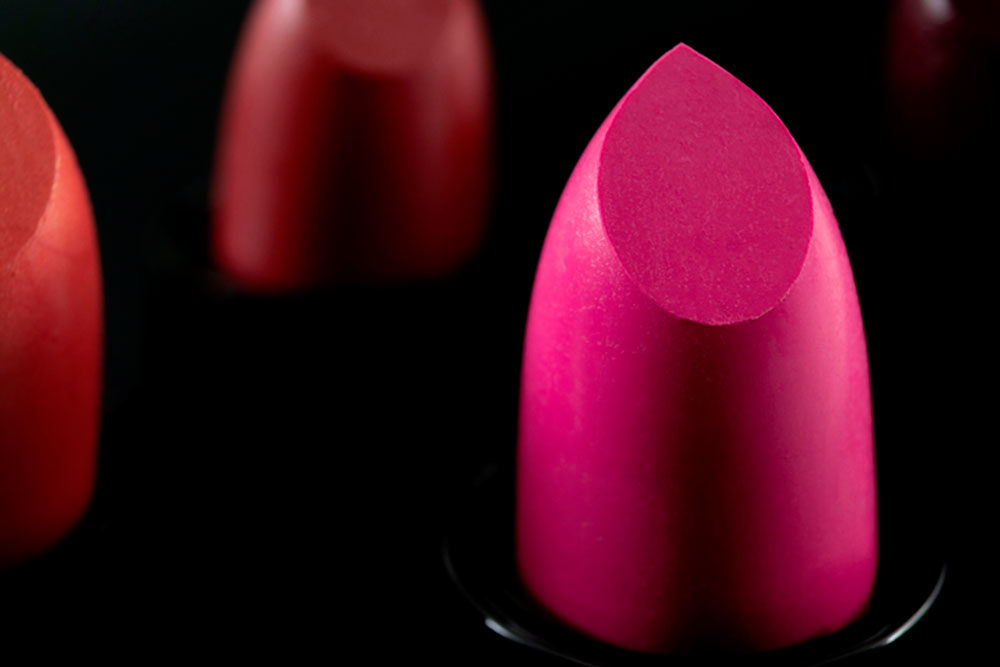
iStock
YOU’VE HEARD of the Lipstick Effect, right? It’s the theory that women spend more money on small, affordable luxuries, like lipstick, during economic uncertainty and potentially unstable times. Purchasing an inexpensive item like that is a treat that doesn’t have much impact on one’s available fund
But whatever the ups and downs of politics and the economy, I suspect that we grown-up girls buy lipstick—both inexpensive and not—because it makes us feel confident and powerful. A swipe of color on the lips and bingo, a transformative effect on looks and attitude. Philadelphia lawyer Nancy Gold is fond of the riff on the airplane safety instructions: “In the event of an emergency, apply lipstick before assisting others.”
In honor of National Lipstick Day (ICYMI, it was Monday), we asked MyLittleBird staff and friends to tell us about their favorite brands and colors. Here’s what they said:
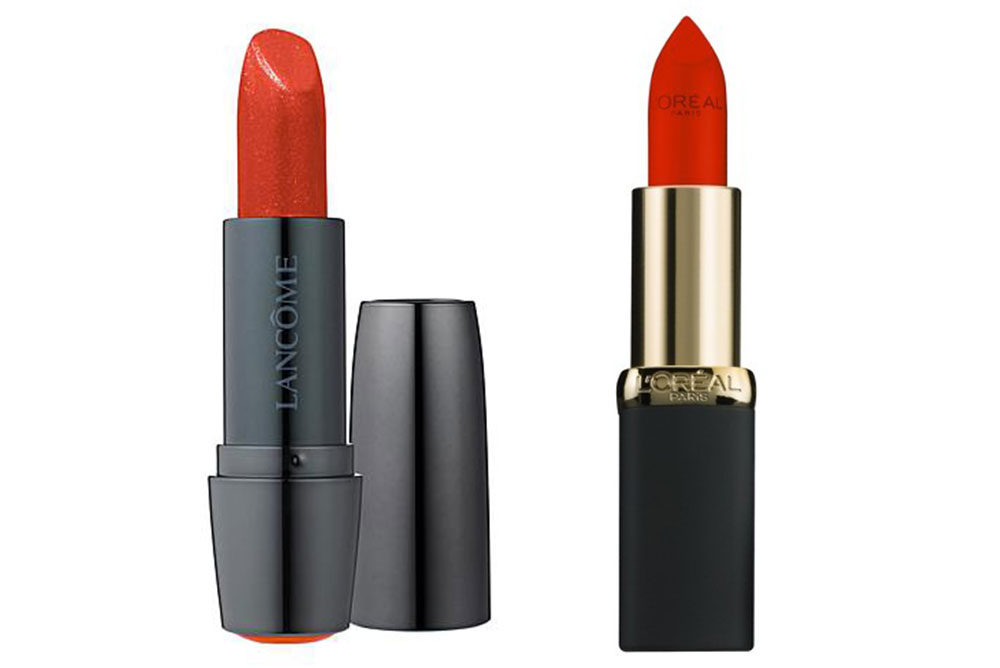
NANCY MCKEON: I just bought a new lipstick! L’Oreal’s Matte-ly in Love (above, right). I wonder about matte finishes, though. As my lips get more and more “approximate” and ill-defined, I think maybe matte is a bad idea. I’ll see.
For almost a decade now I’ve been wearing Lancôme’s Color Design lipstick in the Groupie shade (above, left). It’s a red-orange and has a bit of shimmer to it, which may hide my thinning mouth and give my whole face a color lift. (The color also comes in other finishes, like sheen and matte, even metallic.) The only reason I switched was because I’ve misplaced my lipstick case and happened to be in a Duane Reade.
I think even more important than lipstick at my age is lip liner. I’ve tried the more liquid and waxy kinds, but they don’t sit firmly enough to establish boundaries. I want a matte pencil liner that will define my mouth and then just sit there and shut up. I can color between the lines, although I sometimes use the pencil all over, for a very subdued effect.
The nice thing about makeup in general is that you can be successful at so many price points. A $10 lip pencil from the drugstore may work out better for you than an expensive brand exclusive to Bergdorf’s. And you can mix and match: no reason that $10 lip pencil can’t play nicely with the $175 tinted moisturizer.
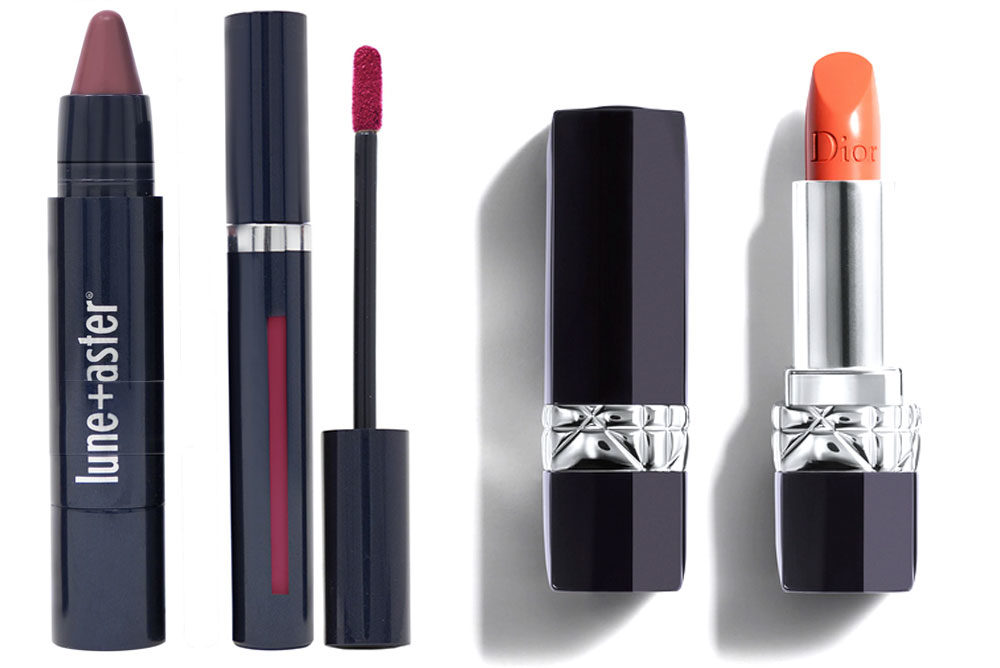
KATHY LEGG: I used to buy primarily Lancôme, and their “free” gifts almost always included a lipstick and mascara so I never had to actually “buy” either. The rosy shades work best for me as do the creamier variety. The matte feels too dry. But no matter what lipstick I wear I swear it doesn’t stay on for more than four minutes and I don’t know why. I don’t lick or touch my lips, but the lipstick just disappears. So I tried lip stains, but never found a color that suited me. Nor did the stains seem to last either. Like Nancy, I’ve used lip liners like lipsticks and they do stay on a bit longer.
Right now I’m using a Lune & Aster color I like a lot. It’s called Double Booked (above, left)—a nice soft rose on the creamy side. I don’t know in how many forms their lipsticks come, but this one is like a big crayon. Kinda fun. I’ve also become partial to Dior’s lipsticks. The label’s Coral Mood (above, right) is perfect for summer. Feels very tropical. But as much as I like them, they don’t stay on any longer than any of the others I’ve worn.
I once saw a clip about lipstick on a daytime TV show called “The Doctors,” where they were warning about the effects/dangers of long-term lipstick use. They were going on and on about the chemicals and gunk used in making it. Yadda, yadda, yadda. You knew it was never going to dissuade any woman from wearing lipstick. But then they brought out this clear container, about the size of a kitchen garbage can, full of something that was supposed to be lipstick and pointed out that this was equal to the amount of lipstick a woman consumes during her lifetime. Now that was pretty gross!
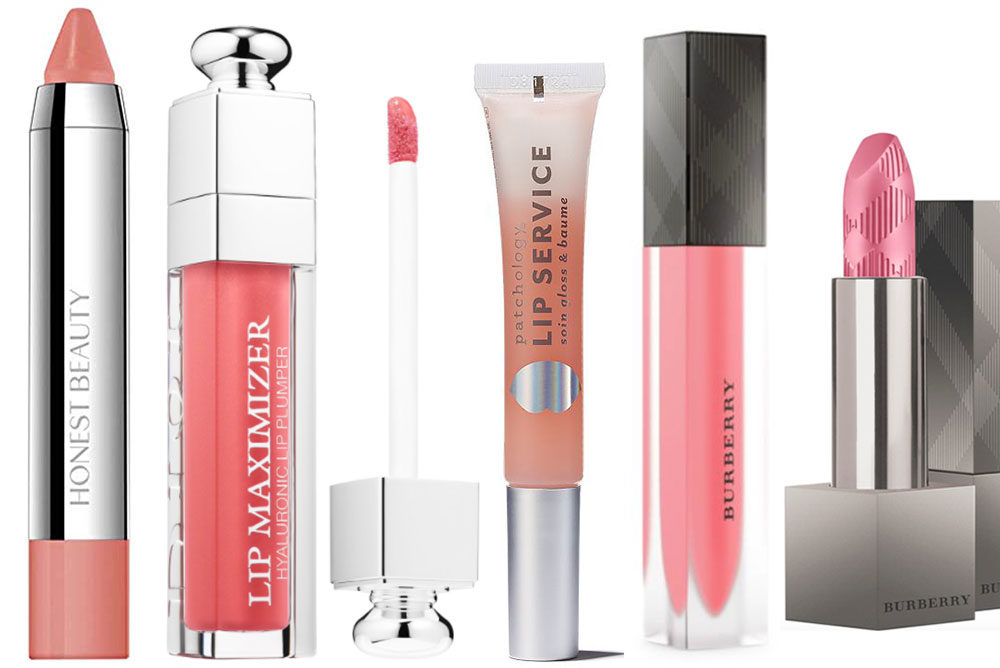
JANET KELLY: For someone who doesn’t wear lipstick much, I must have about 10 different varieties—some crayons (above, far left, Honest Beauty Truly Kissable Lip Crayon), some liquids, some glosses, some, well just plain lipsticks. To soothe dry, chapped lips, I turn to Patchology’s Lip Service Gloss-to-Balm Treatment (above, center). It tastes like honey. My usual go-to combination is Burberry’s Lip Velvet Matte in Nude Rose (above, far right) and to add shine, Liquid Lip Velvet (above, right) in Primrose. I have run out of Dior Addict’s Lip Maximizer Plumping Gloss (above, left), but I miss it because it’s perfect for those times when you need to run out quickly but still want to look as if you’ve made an effort. 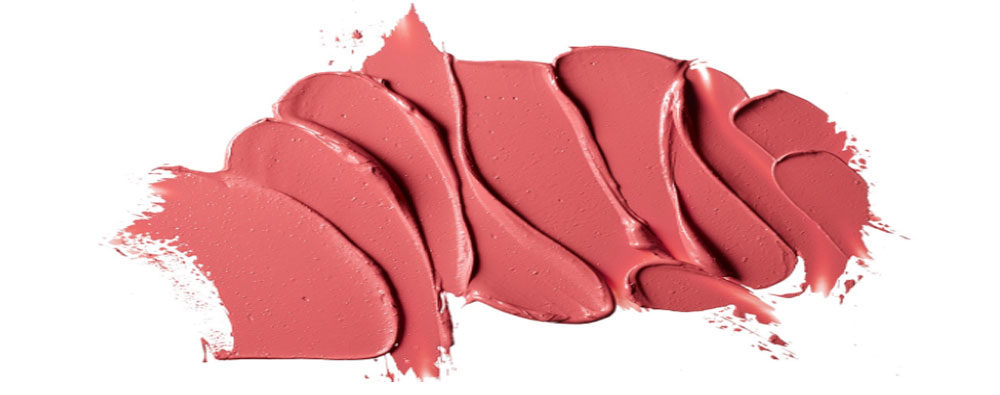
NANCY GOLD: I like the MAC satin finish ones. Right now my favorite is Twig (above). Mattes don’t work for me at all, including the fact that they’re drying on my lips, no matter what they’re billed as. I think as our skin dries out with age, we all need a bit of low shine.
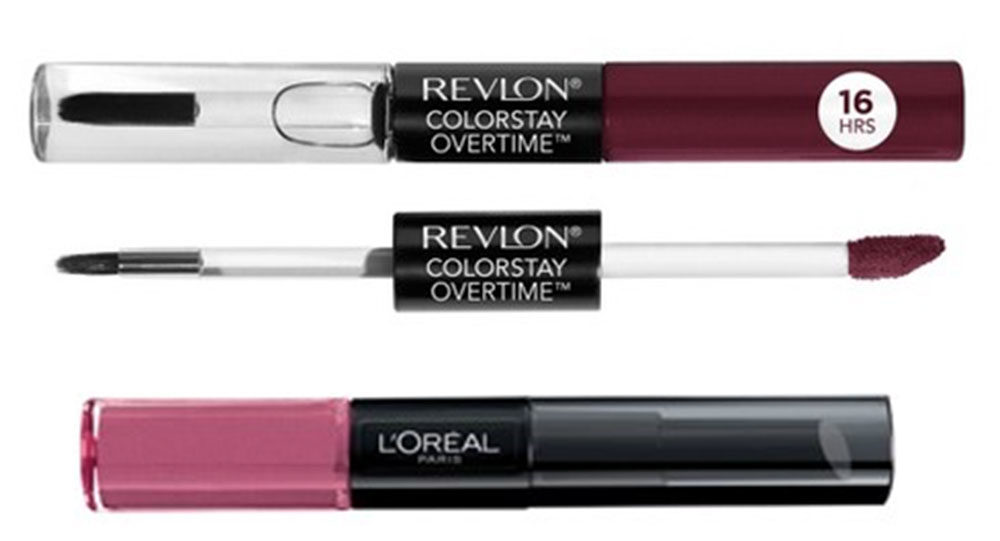
CYNTHIA TILSON: Several years ago, I had Mohs surgery to remove a piece of my upper lip diagnosed with squamous cell cancer in situ. Several weeks later, it was apparent the doctor had done a masterful job of concealing the thin scar, which healed into a barely noticeable white line lost among all the other upper vertical lip lines that come with aging skin.
The last piece of advice my doctor delivered was this: “Do not go outside for even an hour without covering your lips every day in a layer of protective lipstick.” “But,” I complained, “I have never found a lipstick that stays in place long without constant reapplication. What’s a girl to do?”
“Go to the drugstore and buy those 24/7 lipsticks,” he advised. “They last until you either sand them off or remove them with a special makeup remover.”
Since then, I’m never seen without my “lips on,” whether biking, skiing, swimming, or gardening. I used to be a bit snobbish about the lipstick I bought. Now though, every morning I apply my inexpensive drug store go-to —L’Oreal Paris Infallible # 105, with a thin coat of any lip balm containing SPF 30, and I’m set for the day. At least once a week, someone stops to compliment me on this lipstick color—an unusual lavender tint with a hint of iridescence. If I am dressing for an evening event, sometimes I will go bright with L’Oreal’s #215, or dramatic with Revlon Colorstay Overtime in Limitless Black Cherry. At night, I easily remove all the above with Neutrogena make-up remover cleansing towelettes and apply a swipe of Bioderm’s Atoderm Levres for nighttime rehydration.
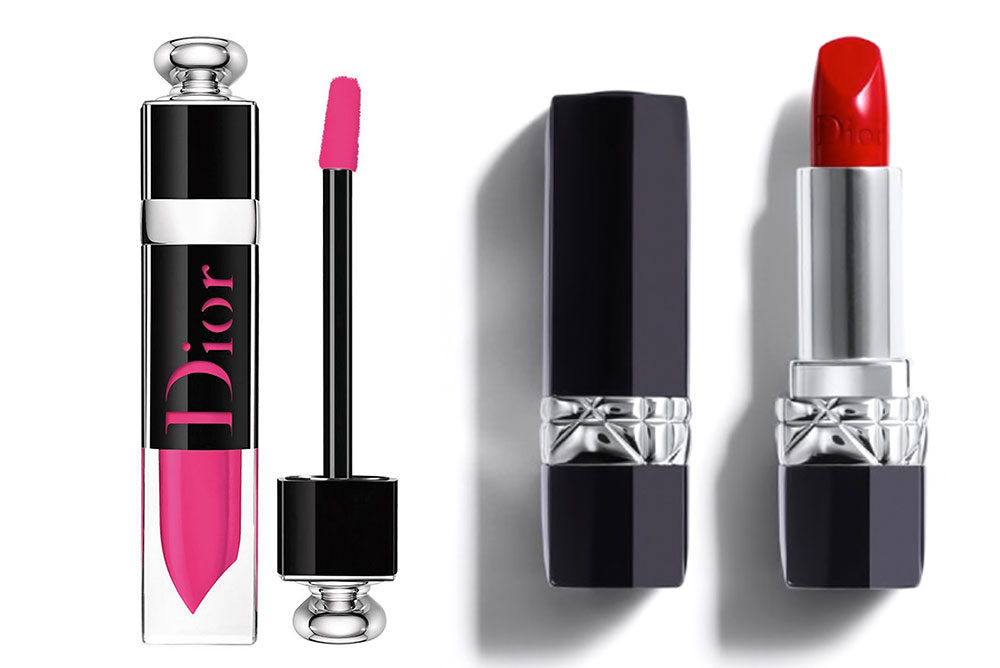
IRINA PERIS: I use Rouge Dior Hot Red (#634), above right) as a base and then layer shades of pink or creamy, shiny things. Those are Dr. Hauschka and Smith and Cult, some with more pink/cream and others with wine shades. Sometimes I use Blush Apple by Burt’s bees and Dior Addict Lacquer Plump in Fever (above left). And that’s pretty much it. I am kind of a minimalist.
Got a favorite color, brand, etc.? Tell us about it! Or in comments below!
MyLittleBird often includes links to products we write about. Our editorial choices are made independently; nonetheless, a purchase made through such a link can sometimes result in MyLittleBird receiving a commission on the sale, whether through a retailer, an online store or Amazon.com.
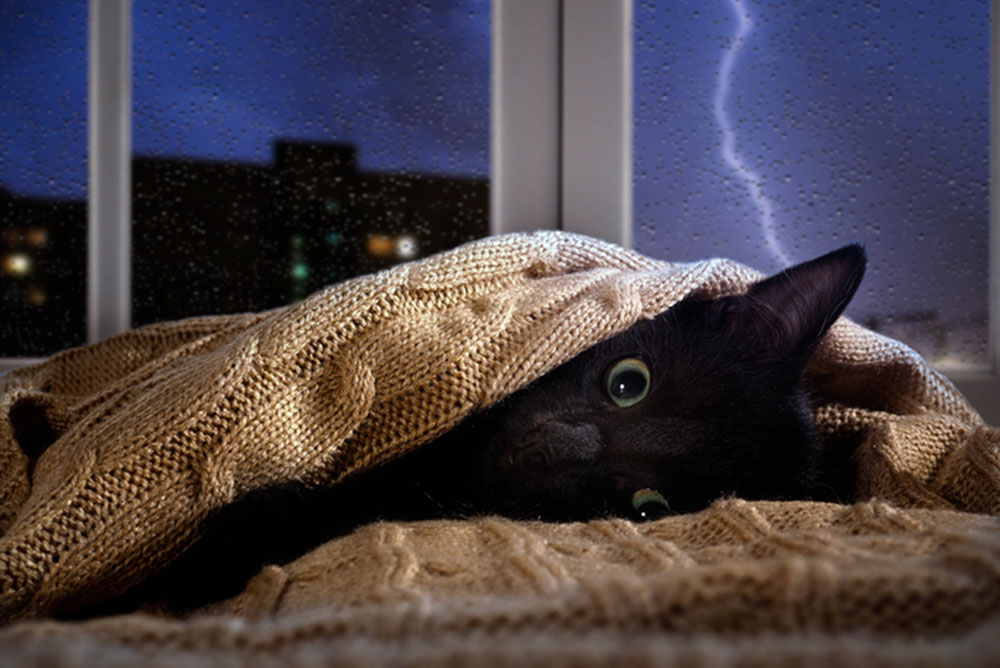
iStock
AS I WRITE this, there’s a thunderstorm raging in the heavens and I am a miserable wreck quaking in my boots. Not really, I’m wearing bedroom slippers but you get the point. I hate thunderstorms, and there is little I can do about it. I have read all the science and still, like those who believe climate change is the result of mankind despite a boatload of evidence against it, I am still scared I could die.
My fear stems from childhood. I was about 10 or 11 when a scary thing happened. My best friend at the time, Adrienne Levine (if she’s out there and anyone knows her, please tell her I’ve been looking for her for years), and I were lying on her parent’s bed watching “The Ed Sullivan Show” on TV. It was a Sunday night, her parents were out to dinner and her older brother who was about 16—his name might have been Allen—was “baby-sitting” us.
It was summer. A hot night. The windows were open. It started raining. There was thunder. Then lightning. Then a bolt of lightning came through the window and struck the TV, which burst into flames. Naturally we ran screaming from the room looking for Allen, who hardly knew what to do himself. I guess he called the fire department because they arrived and put out the fire.
Anyway, I’ve never forgotten that, so whenever there’s a storm I turn off the TV. This annoys my husband who tells me to “get over it.” My son doubts it happened, adding that, “nothing like any of your crazy s…t ever happened to me when I was a kid.”
For once I agree with him: That was some crazy s…t.
—Andrea Rouda
Andrea Rouda blogs at The Daily Droid.
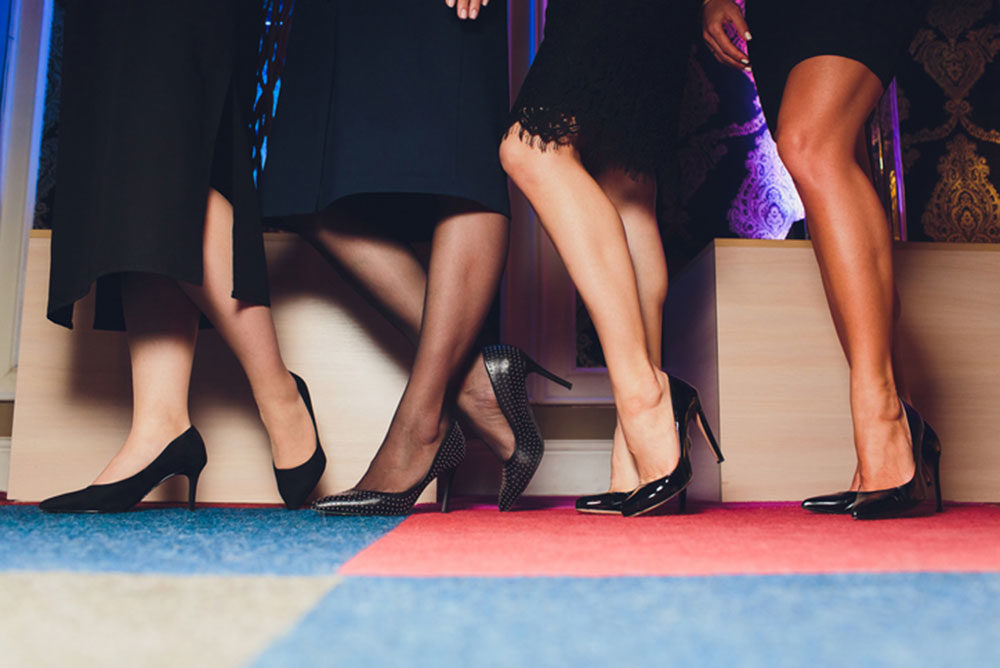
YOU HAVE FINALLY figured out what to wear to a Sunday afternoon barbecue, cocktail party on the patio or lunch alfresco with former colleagues. But, then, oops, you see your chalky calves sticking out from your fabulous, colorful summery dress or skirt. You look more closely and realize the issue is not just your pallid legs. If you’re like me, you’ve got also got some discoloration, a bruise or three, some patchy dry spots and whatnot. My usual solution is to give up and put on yet another pair of pants. But then a friend sent me an email asking if I had any suggestions for hiding spots and pallor on her legs, and I decided to rethink it. Over the years— with varied success— I have tried several solutions, the majority of which have belonged to the self-tanner camp. Reluctant to rely on my own completely random trials, I asked the MyLittleBird team to chime in with their experience. LittleBird Stephanie Gardens, recently back from a week in Florida, where she got a glorious glow but was now sitting in her office gradually growing pale, had some thoughts about her trials (and errors). Here are nine products we think are worth giving a chance. Summer’s too short to let it go by without showing a little (or a lotta) leg.
—Janet Kelly

FROM LEFT TO RIGHT: I don’t use self-tanning products on my face. Rather, I prefer to use those intended for the face on my body, hoping to get a more subtle effect. That could be a pretty pricey indulgence in the case of ByTerry’s Terrybly Densiliss Sun Glow ($92.80, Dermstore). In the spirit of full disclosure, I received a sample from the cosmetics company a year or so ago. Because it reportedly blurs skin imperfections and blemishes, I tried it on my legs and got just enough of a bronze color to hide the parts I wanted hiding. Irishwoman Alyson Hogg was making skin care products when her friends (very pale Irish lasses looking for something to darken their skin) convinced her to come up with a tanning product. One of the results is her company Vita Liberata’s Body Blur Instant HD Skin Finish ($45, Violet Grey), a wash-off face and body makeup that gives you a bronze glow, reflects light and reduces the appearance of spider veins and age spots. Several years ago, I bought something from James Read that gave my gams some shine. Although it did leave a slight dark stain on the inside hem of my skirt, the dry cleaner resolved it. I’d give the company’s Tan Instant Body Mist ($38, Dermstore) a try. The spraying part sounds appealing, although you’d have to be careful not to miss. The best thing about pads/towelettes, like those fromTan Towel, is they’re easy to apply and don’t leave spills all over the bathroom. I first I discovered them in one of those jars of samples Bluemercury in Georgetown keeps around the cash register. Last summer I swiped the Total Body Tan Self-Tan Towelettes (set of 5, $29, Ulta Beauty) on my legs before I set off for a beachy vacation. With several applications, I built up enough coverage to wear a sundress. It dried quickly and didn’t smear on my clothes. As opposed to my method, Stephanie used St. Tropez Instant Glow on her face, even though it’s meant as a body tanner. “It’s temporary color, but does not run or streak even in the hottest weather, yet washes off easily with soap or cleanser. It appears they no longer make it.” Alternatively, there’s St. Tropez Tanning Essentials Gradual Tan Everyday Tinted Body Lotion ($30, Sephora).

FROM LEFT TO RIGHT: “SugarBaby Radiance Wash off Bronzing Moisturizer Cream ($11.39, Amazon) got good reviews on Amazon, and I agree,” says Stephanie. “It’s a temporary body tanner that I use on my face—it’s very dark, but believable if you’re not too pale or have a base tan. And cheap. I’ve also used Sublime Bronze Hydrating Self-Tanning Water Mousse ($14.99, Ulta Beauty), but to my nose it is toxic. It does, however, give excellent color and dries quickly.” Stephanie has gotten good results from Dennis Gross Skincare’s tanning products, such as Alpha Beta Glow Pad for Body (set of 8 pre-soaked pads, $45, Dermstore), but decided to find something less spend. She reports: “I scored Jergens Natural Glow Wet Skin Moisturizer at Harris Teeter the other day—half price, around $5,” she says. (It’s $10.99 at Ulta Beauty.) “I’m using it on my legs and belly; I hate a pale stomach. So happy I went back and immediately bought another tube in Medium Tan, because that’s what I currently am. It goes on smoothly over damp skin; you pat dry, and it leaves no smears or streaks. Moreover, there’s only a very mild, inoffensive scent, as opposed to their old gradual tan stuff which positively reeked. It IS a little yellowish, but my Florida tan (why are tans from different places so different?) is a bit yellow.”
MyLittleBird often includes links to products we write about. Our editorial choices are made independently; nonetheless, a purchase made through such a link can sometimes result in MyLittleBird receiving a commission on the sale, whether through a retailer, an online store or Amazon.com.
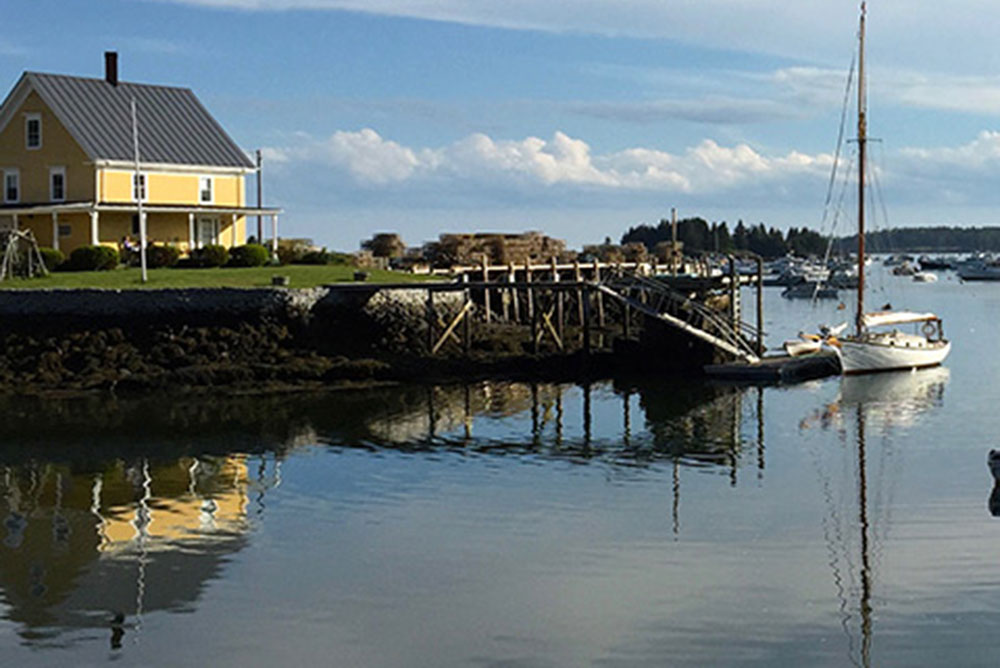
vinalhaven.com
MY HUSBAND and I spent the last three days out of this world and it was great. We never saw a TV, never caught glimpse of a newspaper, couldn’t surf the Internet due to spotty service, and never heard, not even once, anyone utter the word “Trump.” All it took was a 75-minute ferry ride to an island called Vinalhaven 13 miles off the coast of Maine to truly experience the state’s motto, “The Way Life Should Be.”
Vinalhaven is to Maine what Maine is to the rest of the United States: really out there. Occupying roughly the same land area as the isle of Manhattan (168.7 sq. mi.), although shaped differently and sharing no characteristics whatsoever, I’m pretty sure God has a summer place there. Now at this late stage of my life I want one too.
In general all things were better there, including lemon meringue pie. (See photo.) The weather was at least ten degrees cooler than on the mainland, which is blissful on a sweltering summer day. And while there are cars there’s no traffic, or traffic lights, or parking meters. You just drive where you want to go and when you get there you pull over, turn off the engine and get out, leaving your car unlocked if you choose since there are no criminals either.
But if you ask me, the best thing about Vinalhaven is the lack of brew pubs, which are suddenly and alarmingly taking over the state, and likely the world. There’s a huge one the size of a factory (and still growing) less than a mile from my home in teeny-tiny Freeport, and three more in the town proper. Even the mystical, magical Monhegan Island, just 4.5 square miles in size, now has one, and last time I was there you had to wait in line for a seat, which was actually a lobster trap put to a more humane use.
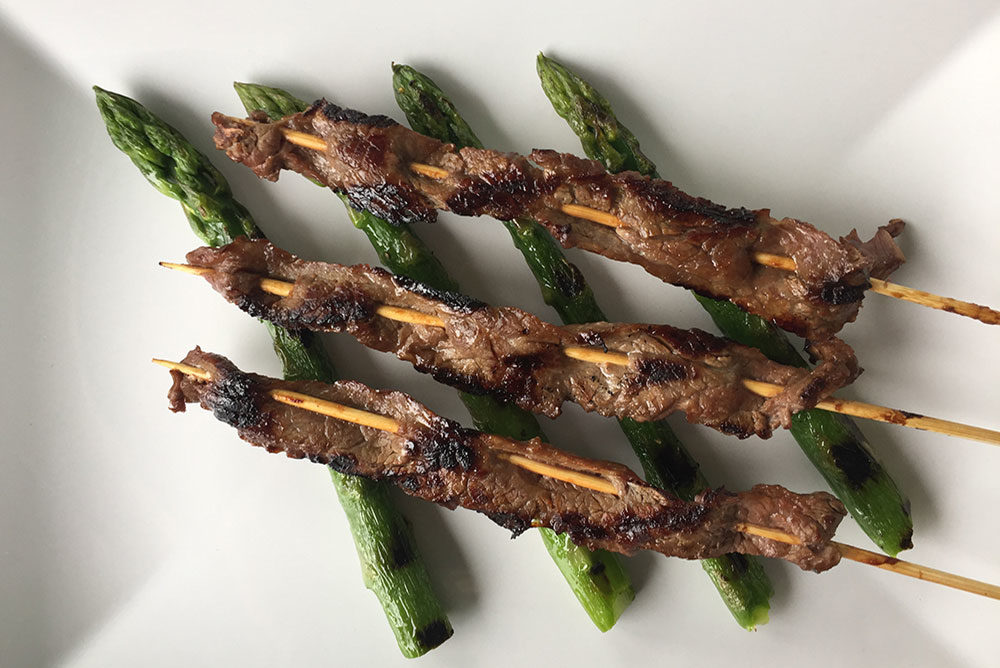
Flank steak on skewers./ Photo by Stephanie Witt Sedgwick.
This dinner-ideas piece first ran the beginning of May last year. Now that grilling season is in full swing, you can’t go wrong with flank steak.
WHEN I MET my husband he could cook and I thought he enjoyed it. He famously wooed me with a dish of pasta with tri-colored peppers. He wasn’t quick in the kitchen; that pasta dish took two hours and two bottles of wine to get done, but he was competent and managed to make some pretty good dinners. Fast-forward many years and it’s as if he never knew how to cook at all. Turns out the early foray into cooking was more a survival tactic than an avocation, and once he had a professional (me) on the job, he didn’t need to fake it anymore.
Luckily, there is one cooking task he still is always willing to perform. No tough guessing game here, he loves to grill. He goes out there with a drink in one hand and his instant-read thermometer in the other, happy as can be. So as the weather warms, he is more than willing to heat the grill and get cooking.
Well, it’s plenty hot now and not so ideal for grilling, which itself is a hot business. Given this full-on heat assault, there’s no shame in grilling earlier in the day, when the sun is low in the sky. And if you’re not a mosquito magnet you could wait till late. Anything but that full-bore sun.
My husband has his favorites at the grill, and a big one, as it is for so many people, is flank steak. When I was working at the Food section of the Washington Post, we published a recipe for flank steak in a teriyaki marinade, and you would have thought we had invented the thing.
Now I like flank steak, too. It’s full of flavor, takes well to marinades and is great cold the next day, which meets my list of of requirements. Better yet, there are plenty of things you can do with a flank, besides serving it grilled and thinly sliced.
— Stephanie Witt Sedgwick
LittleBird “Stephanie Cooks” has been writing about food and cooking for more than 20 years.